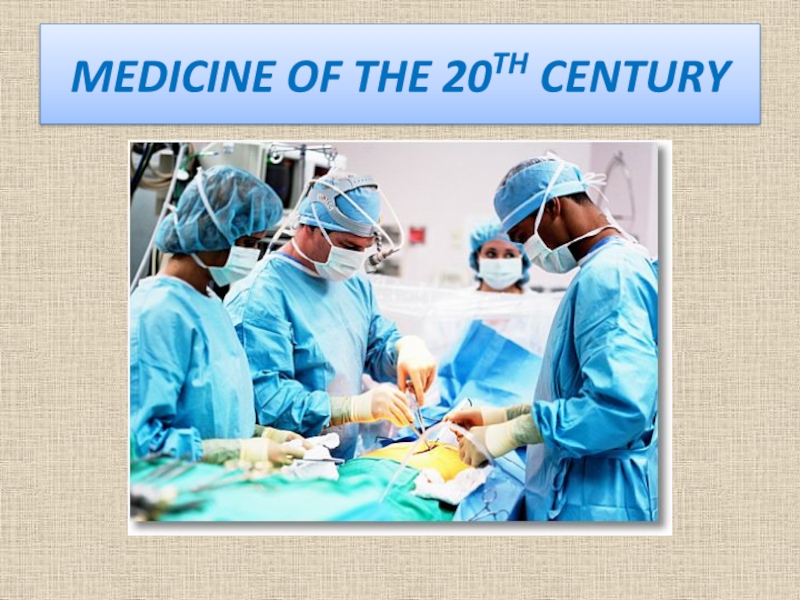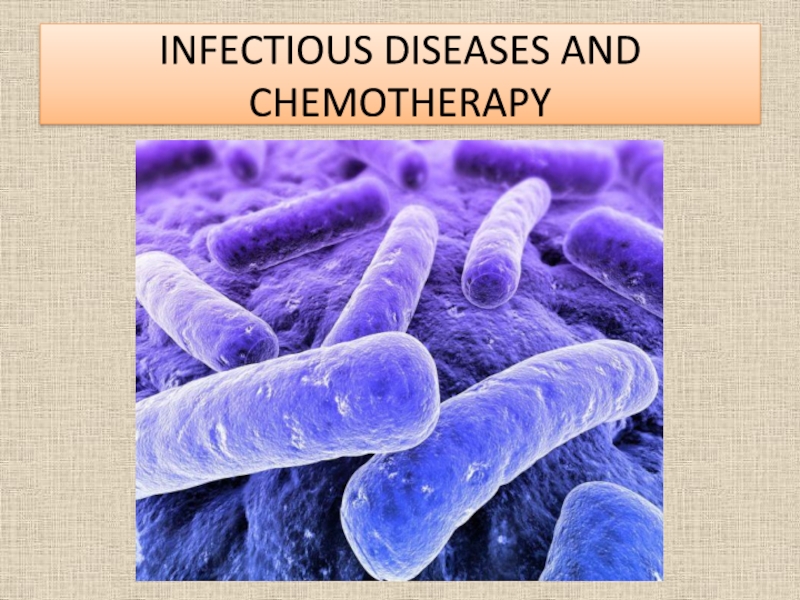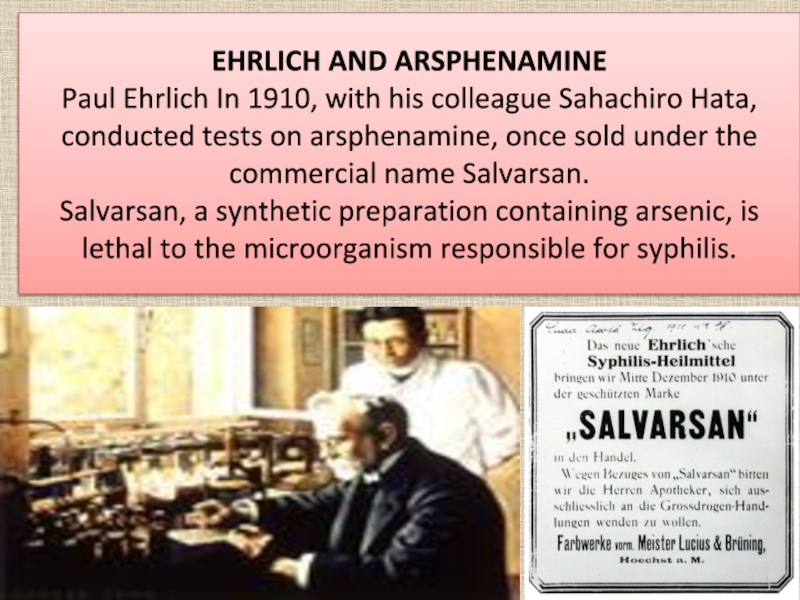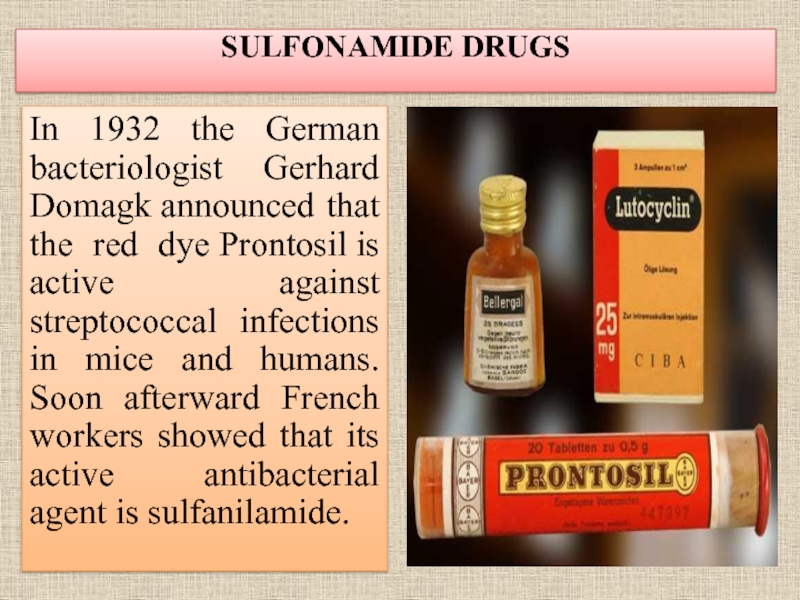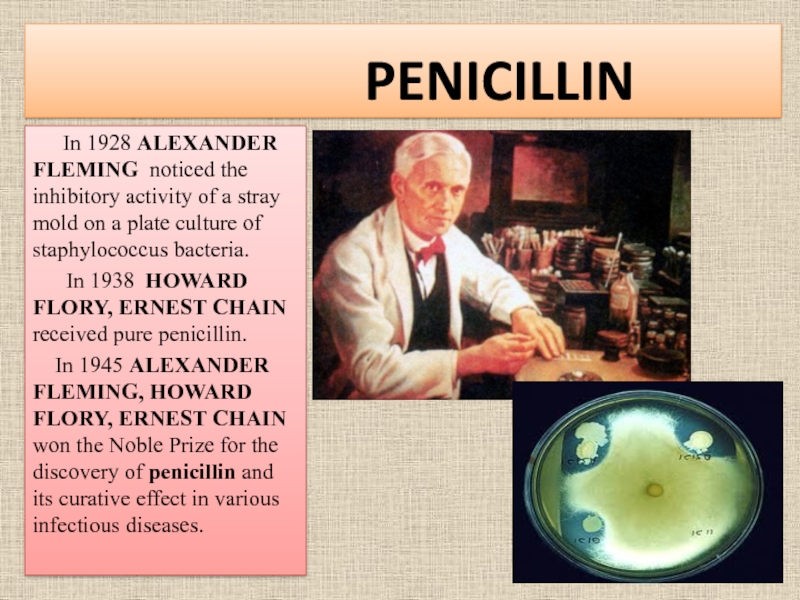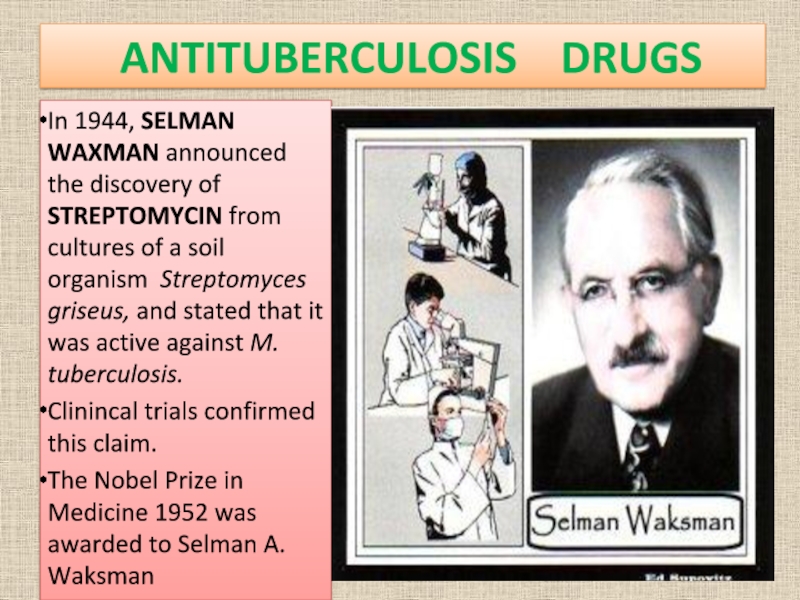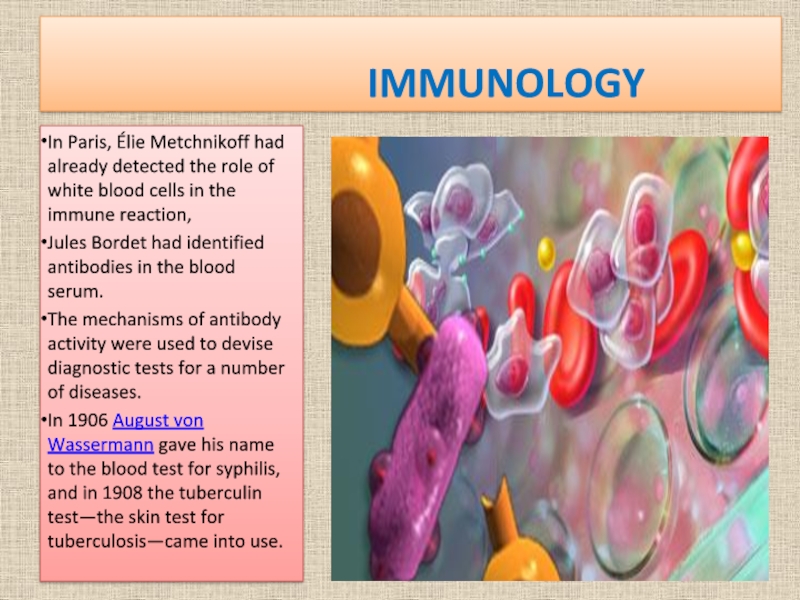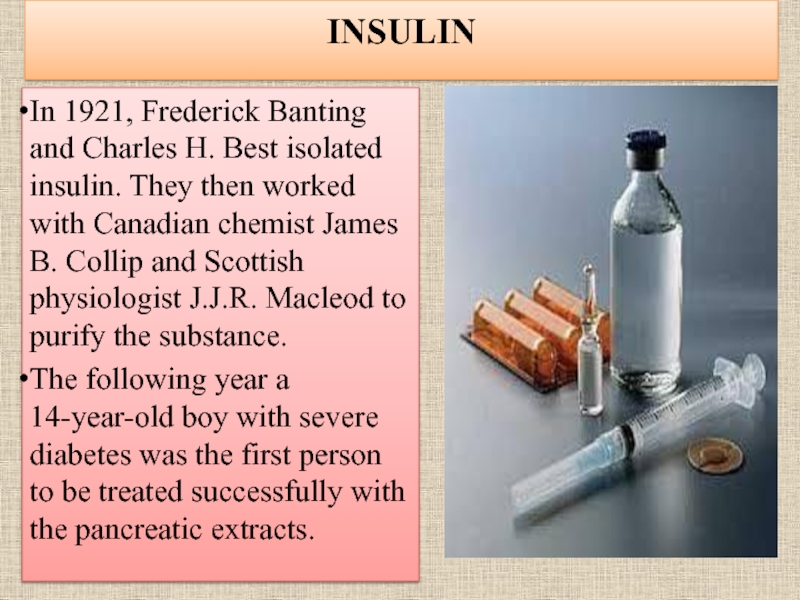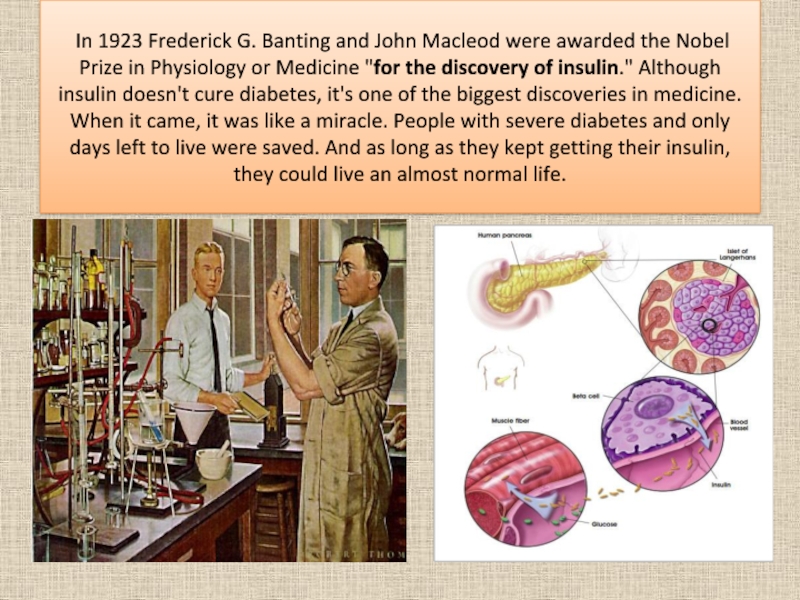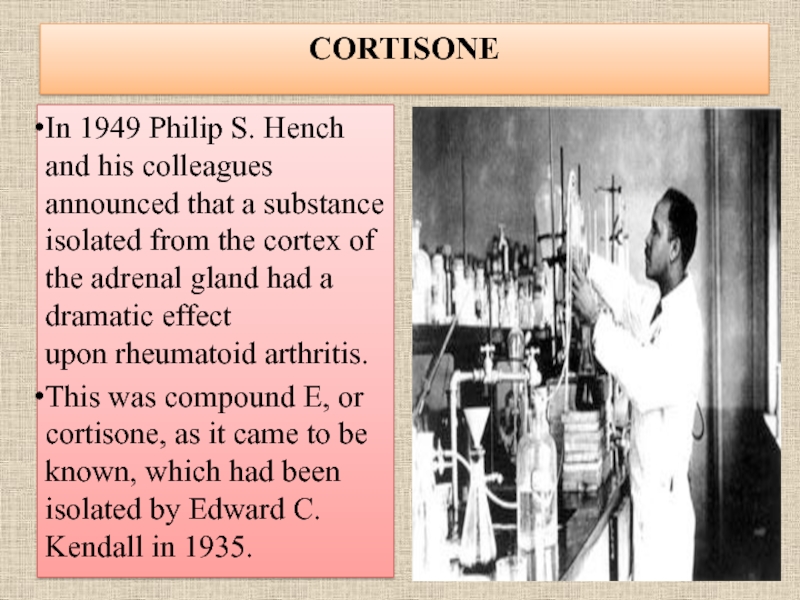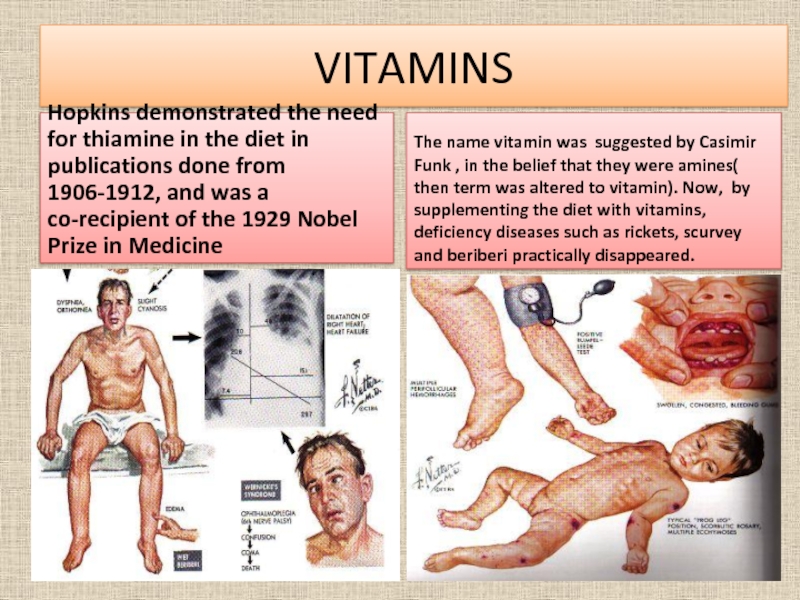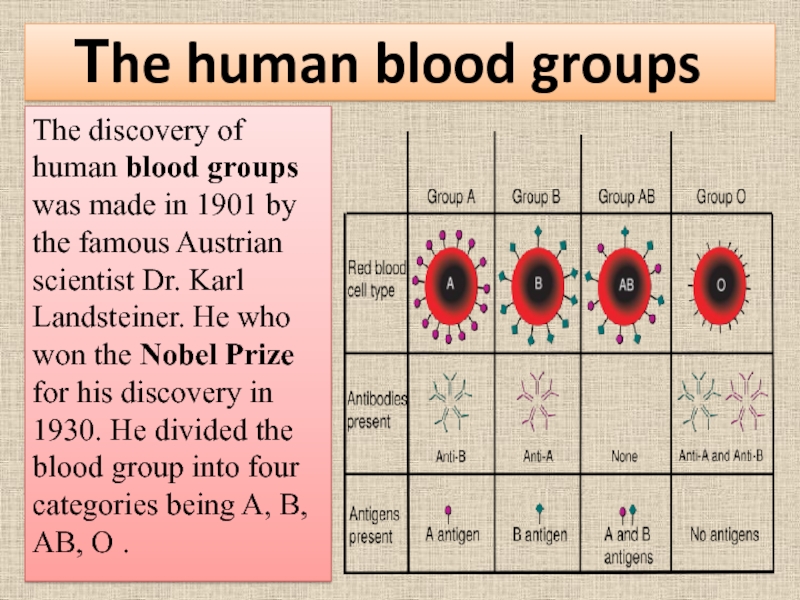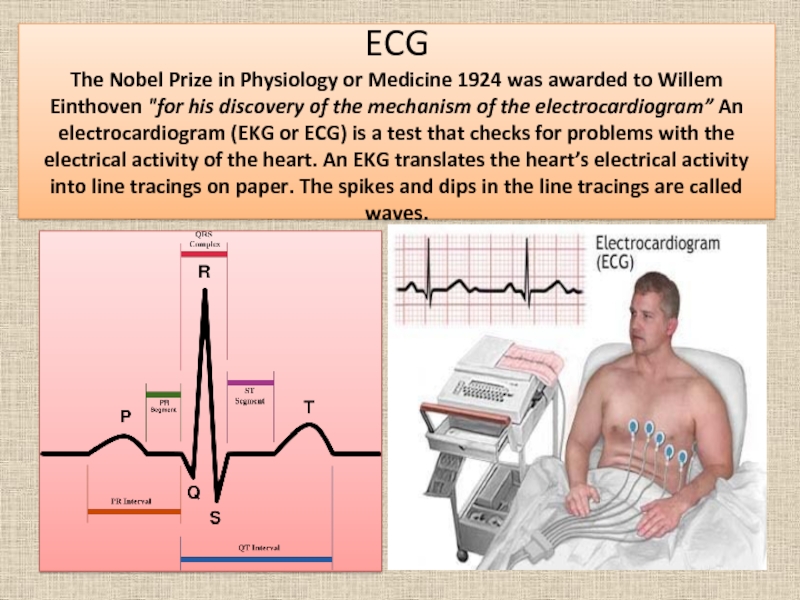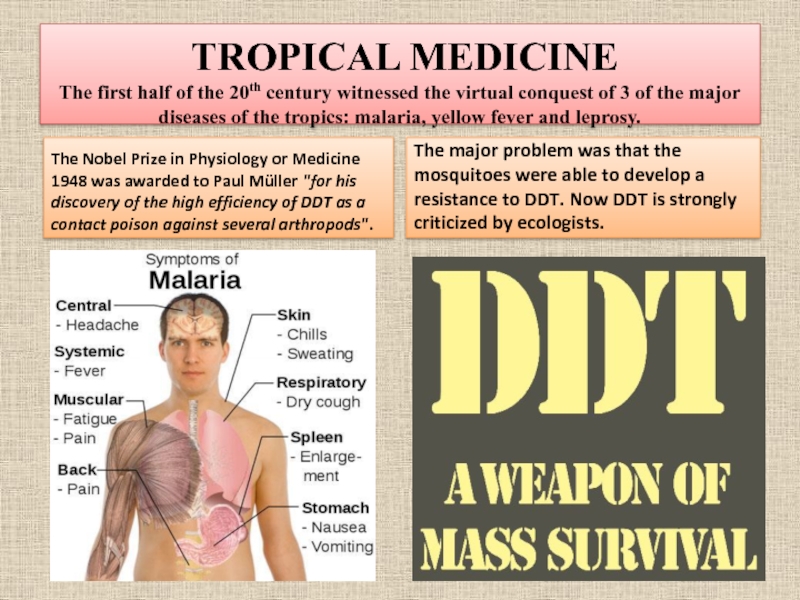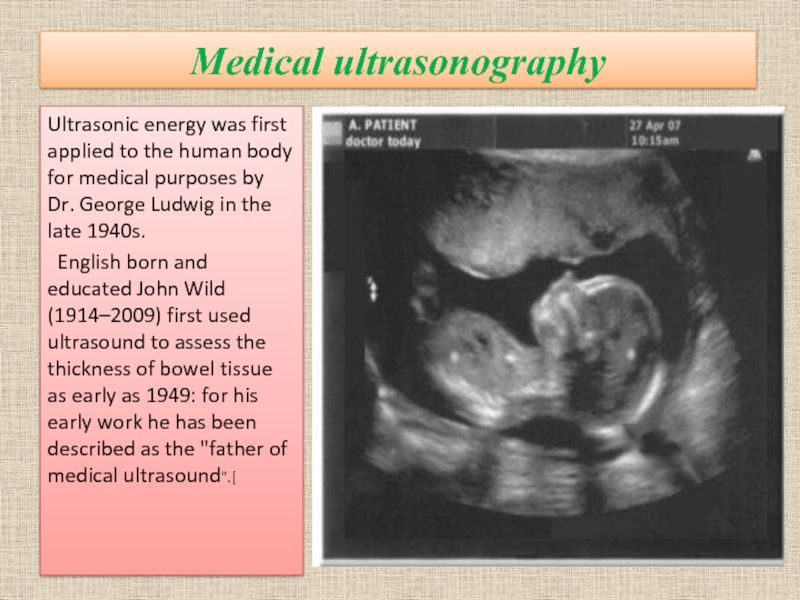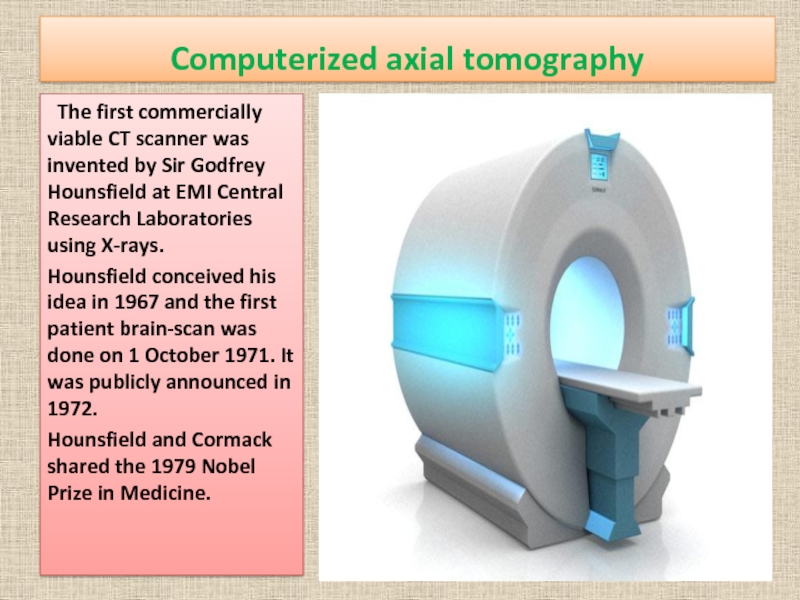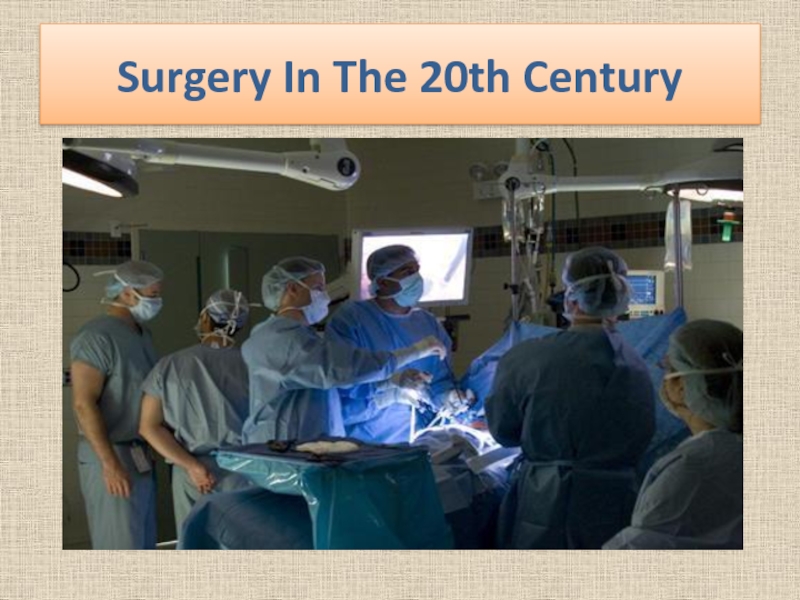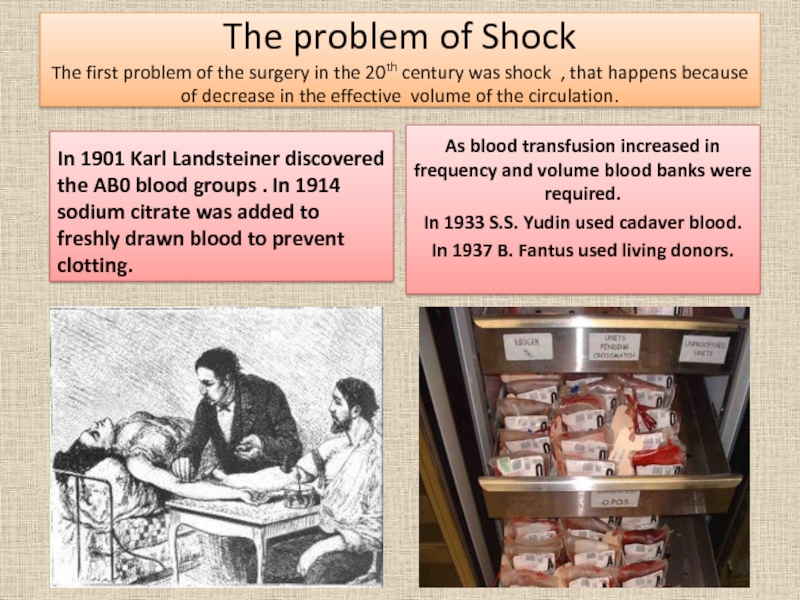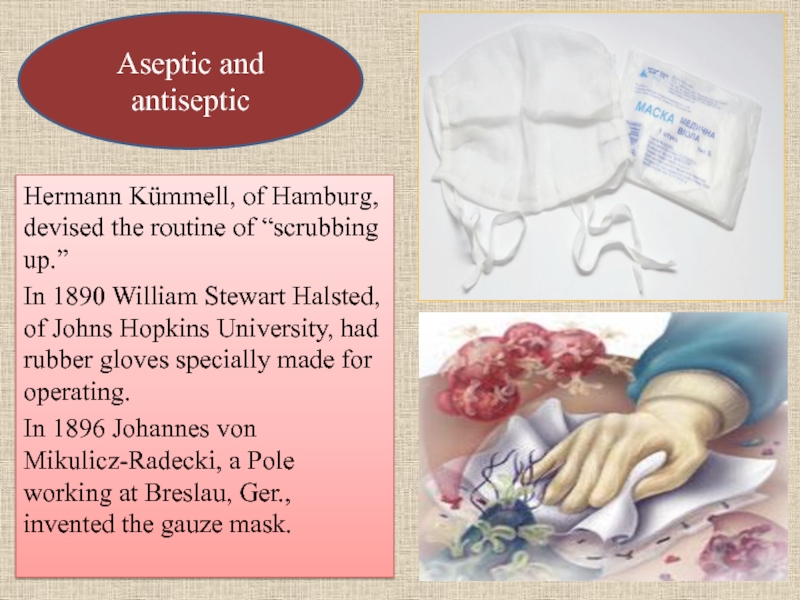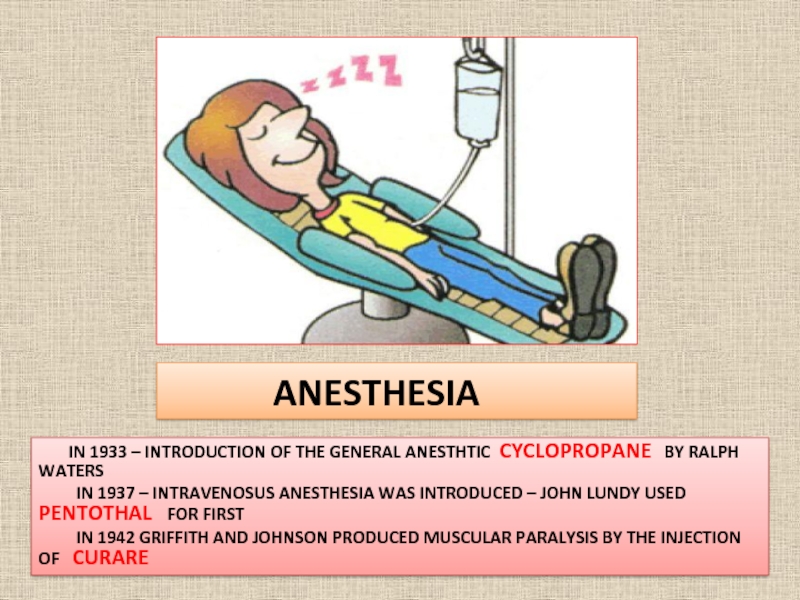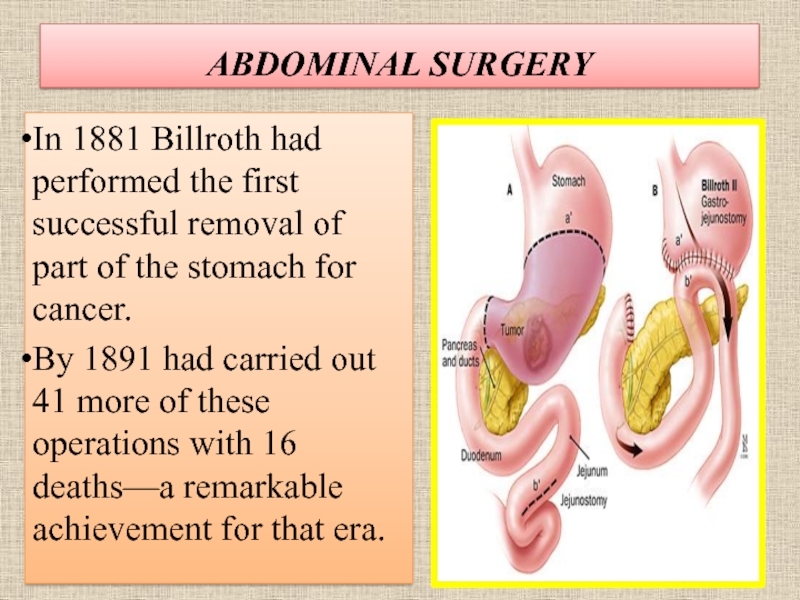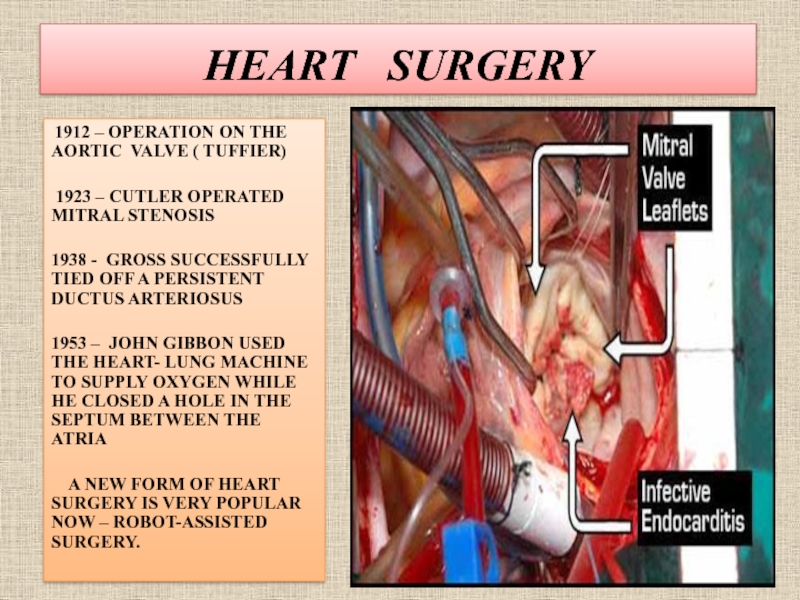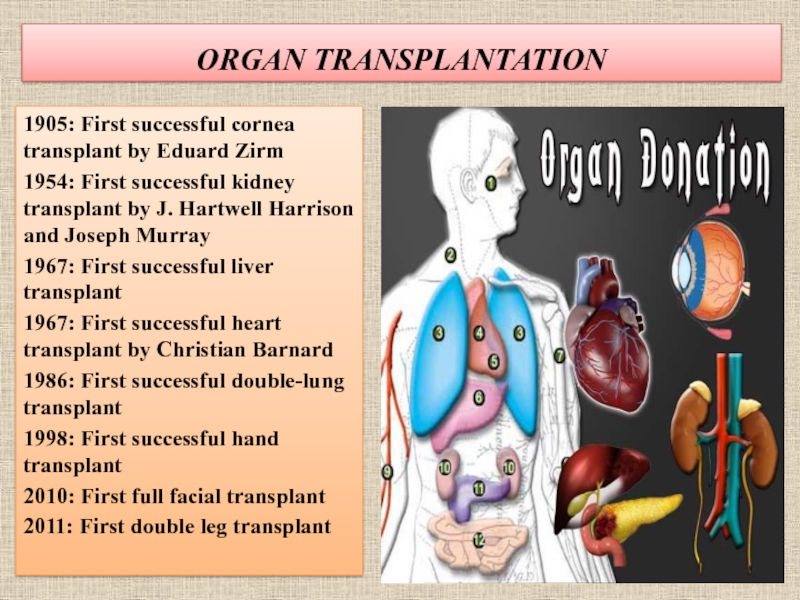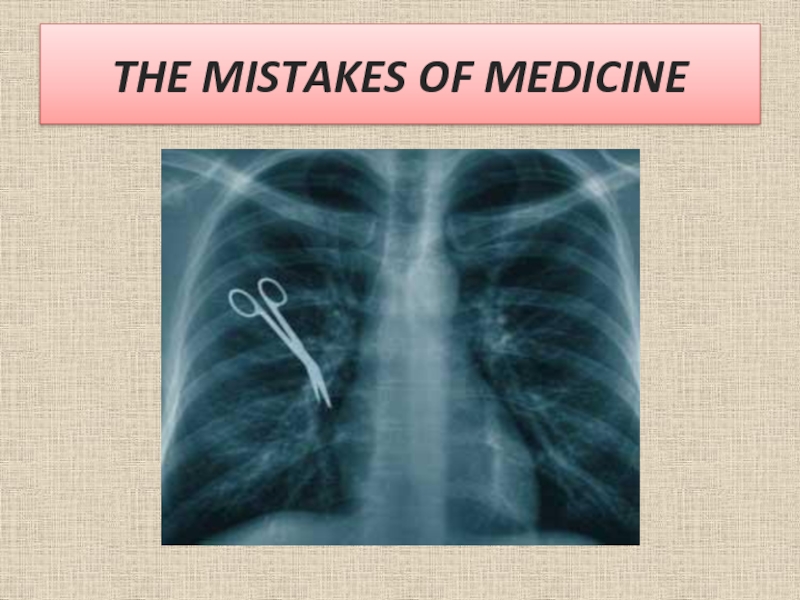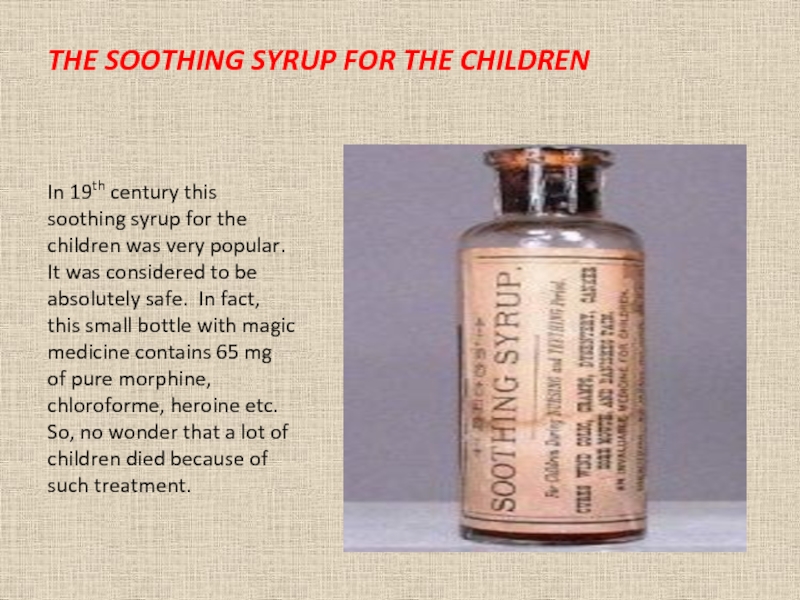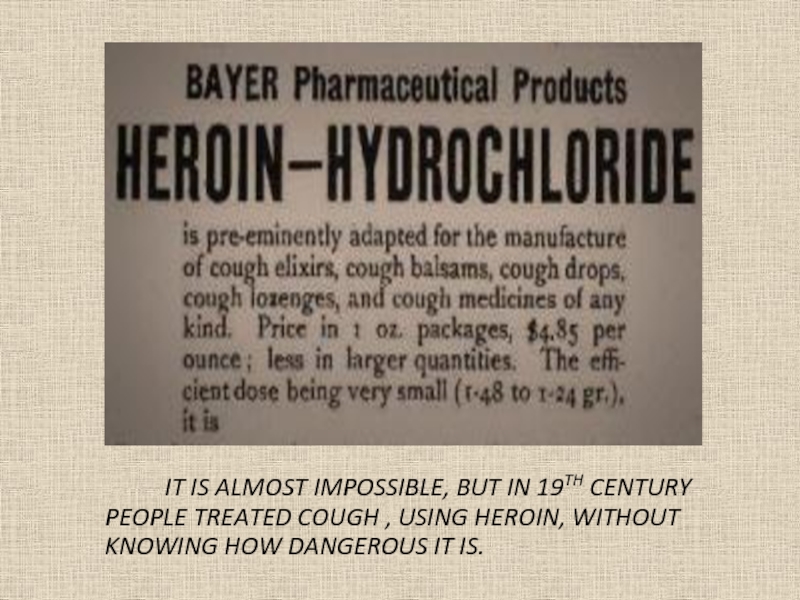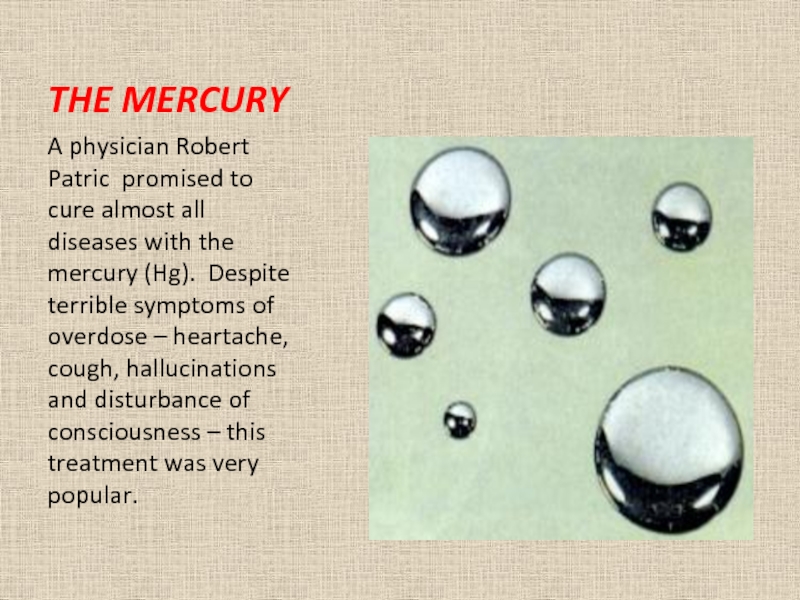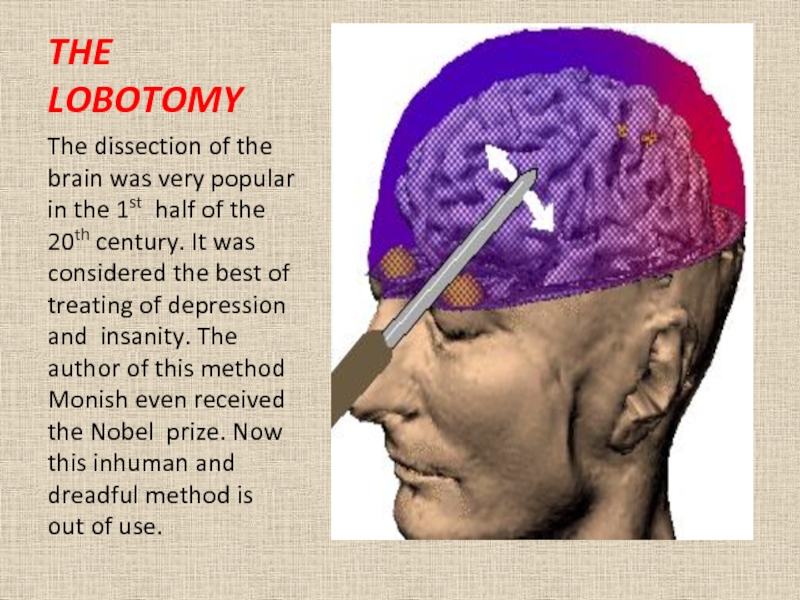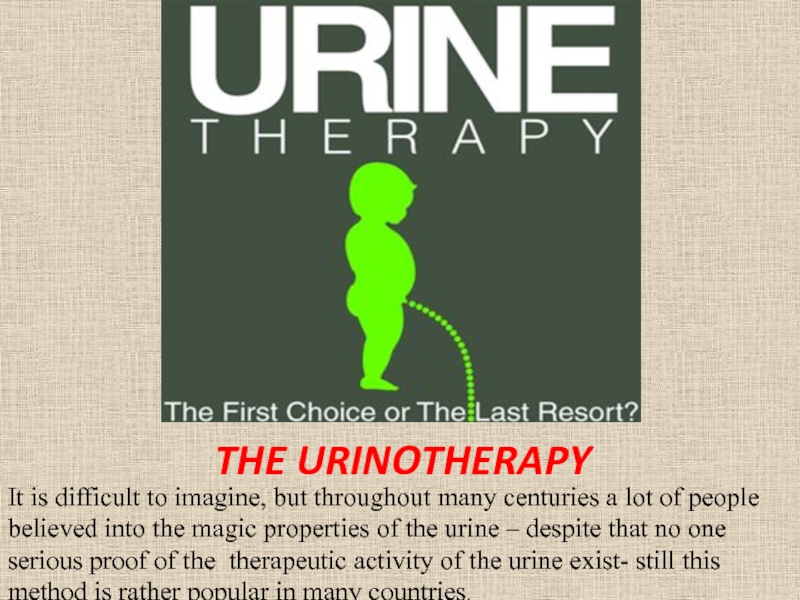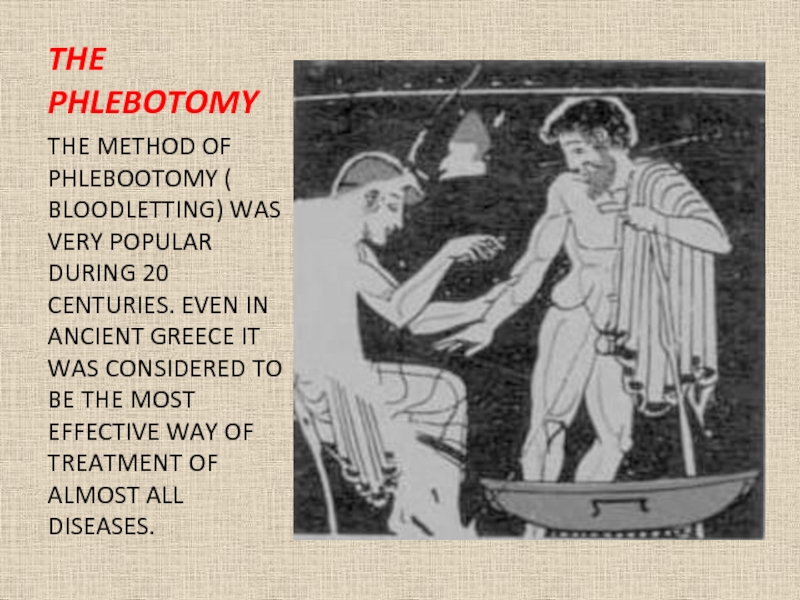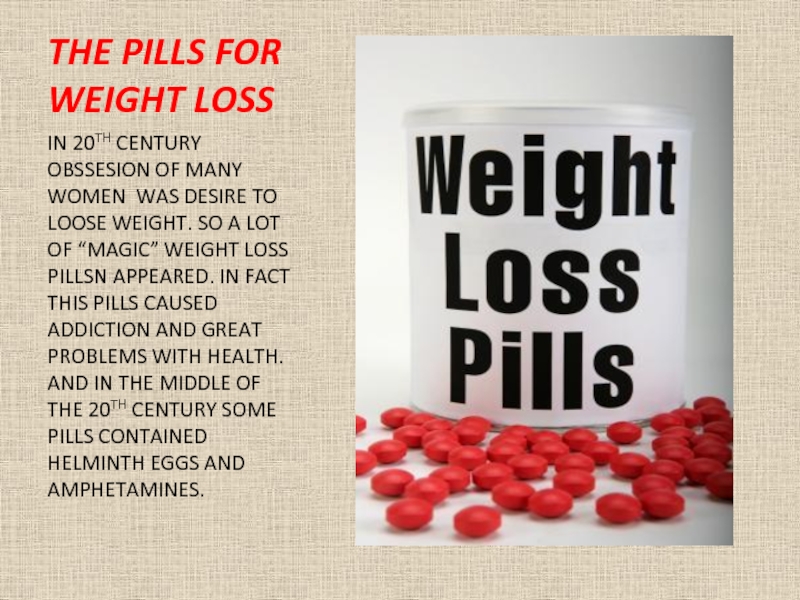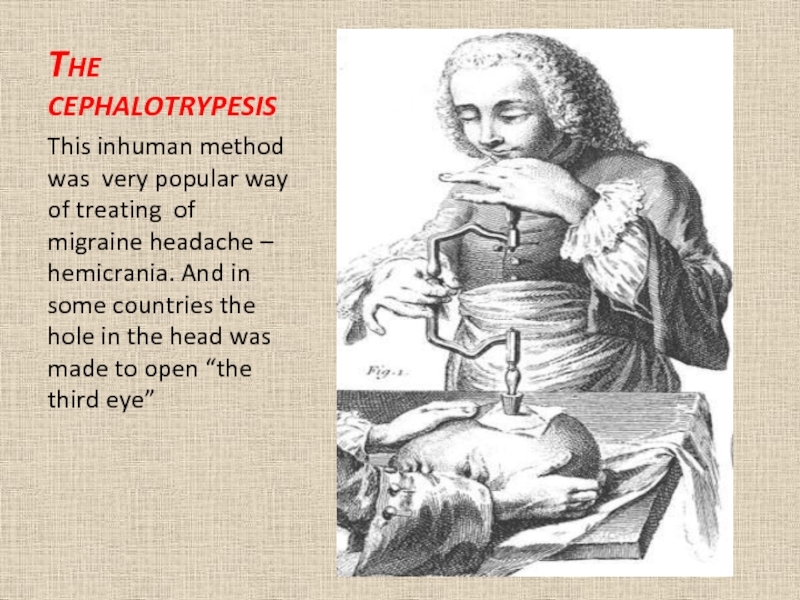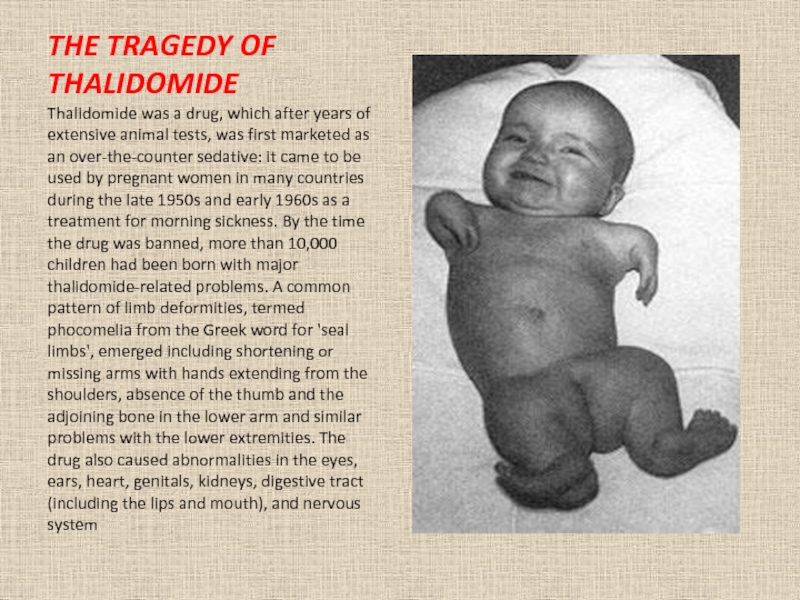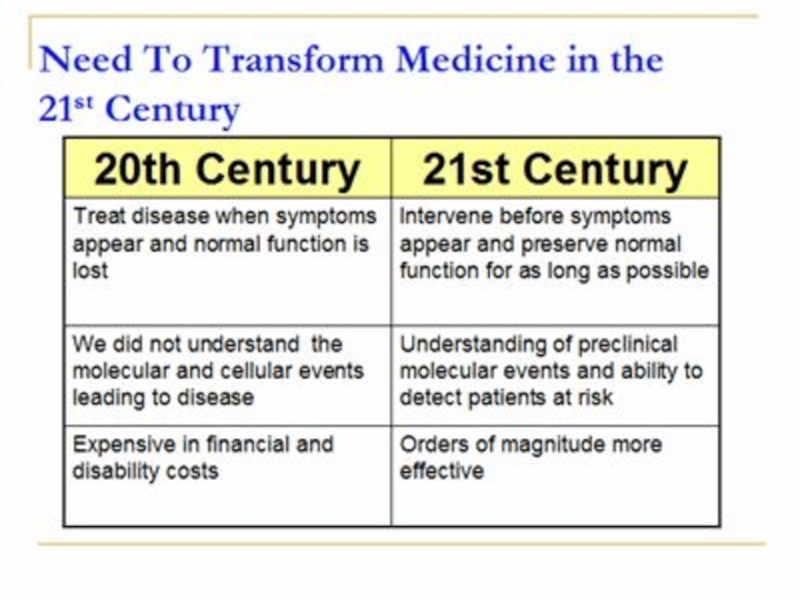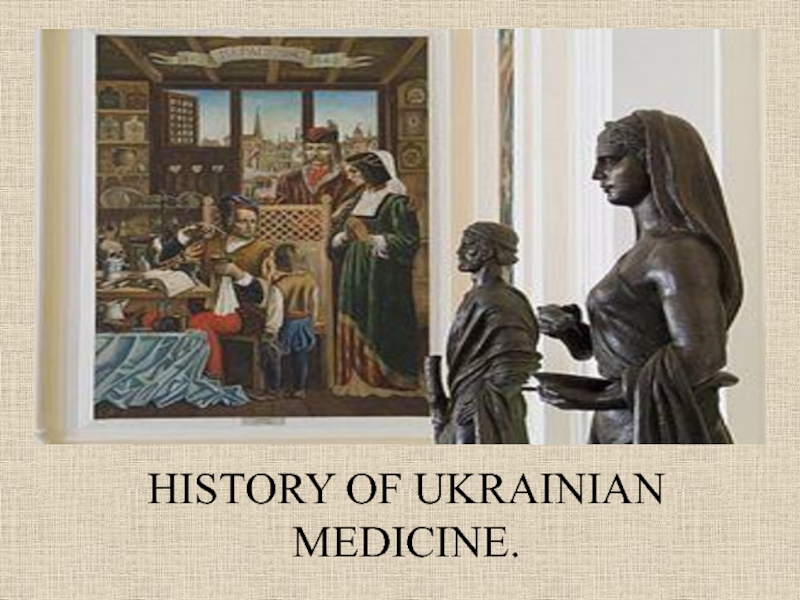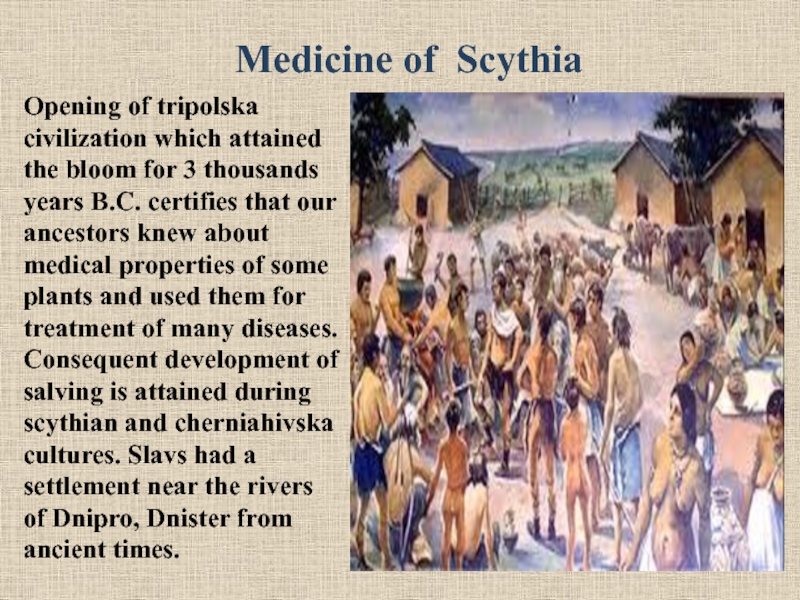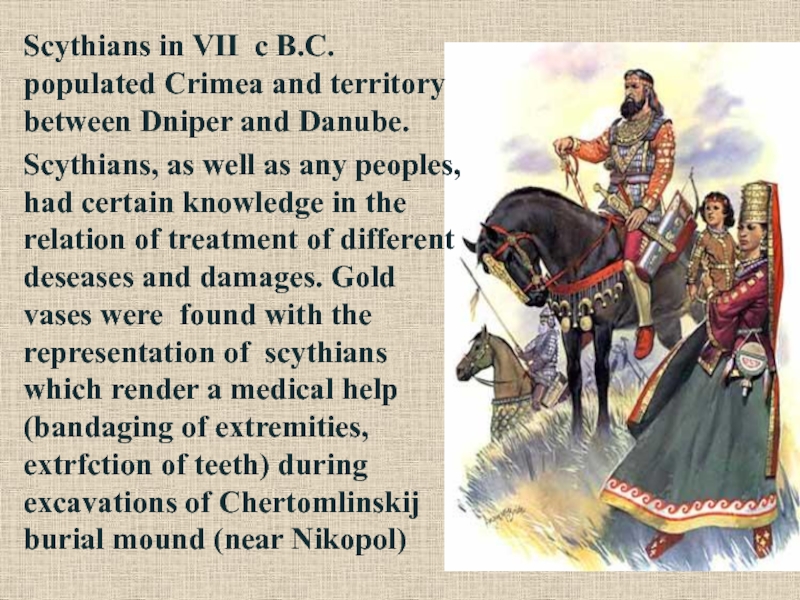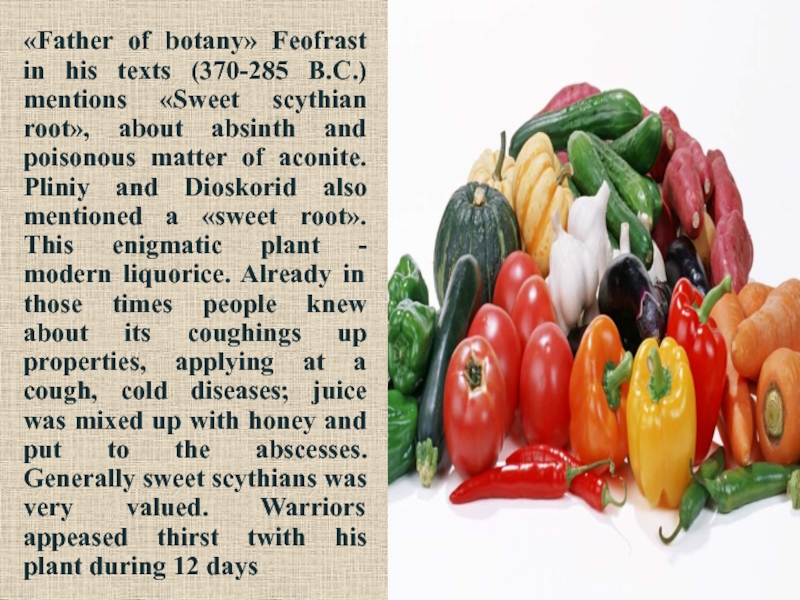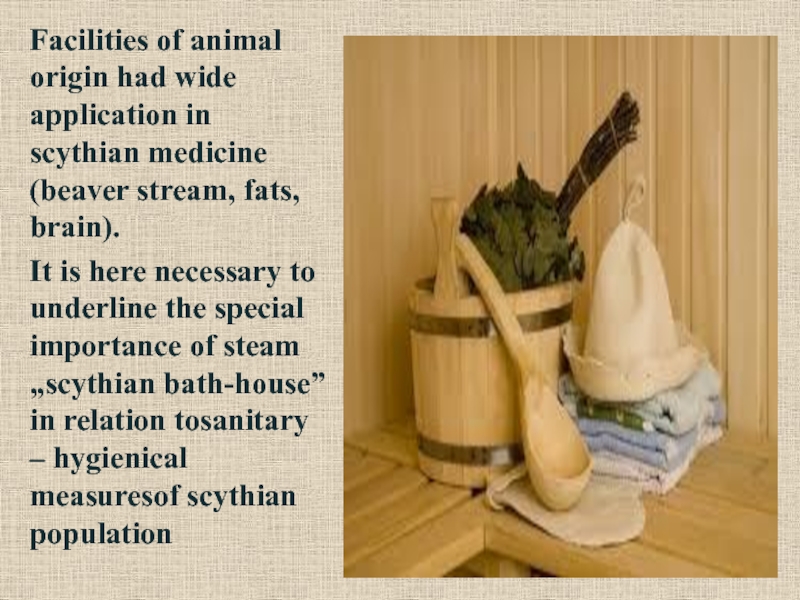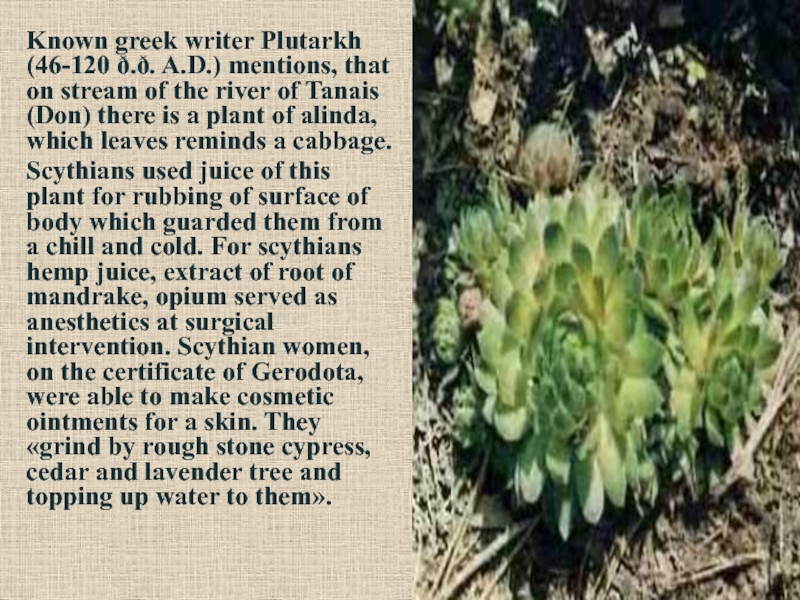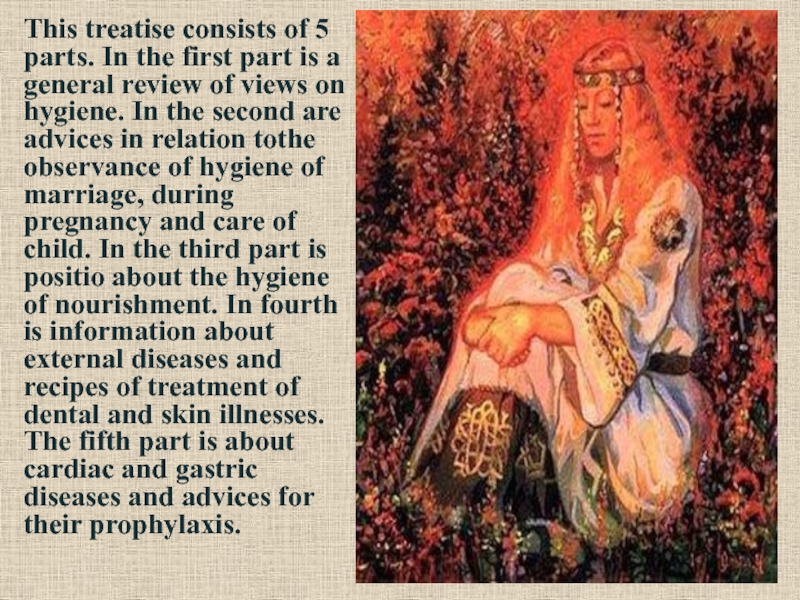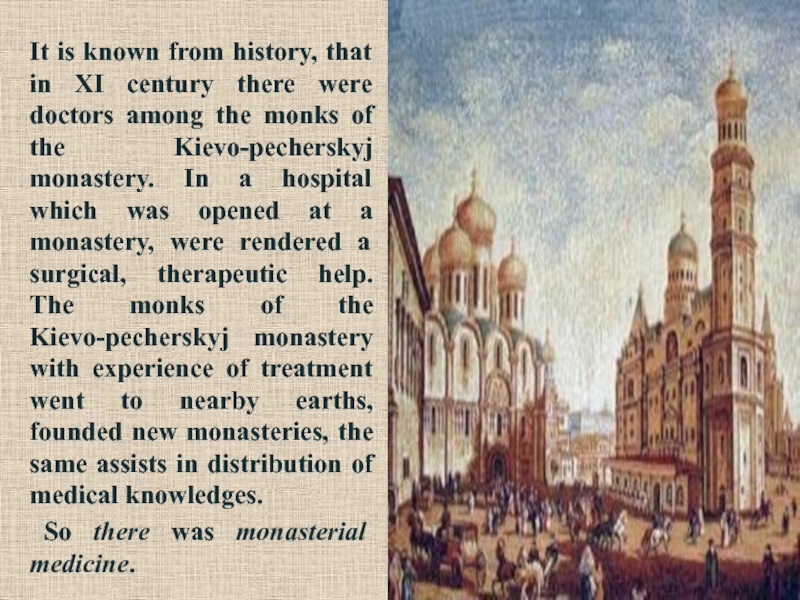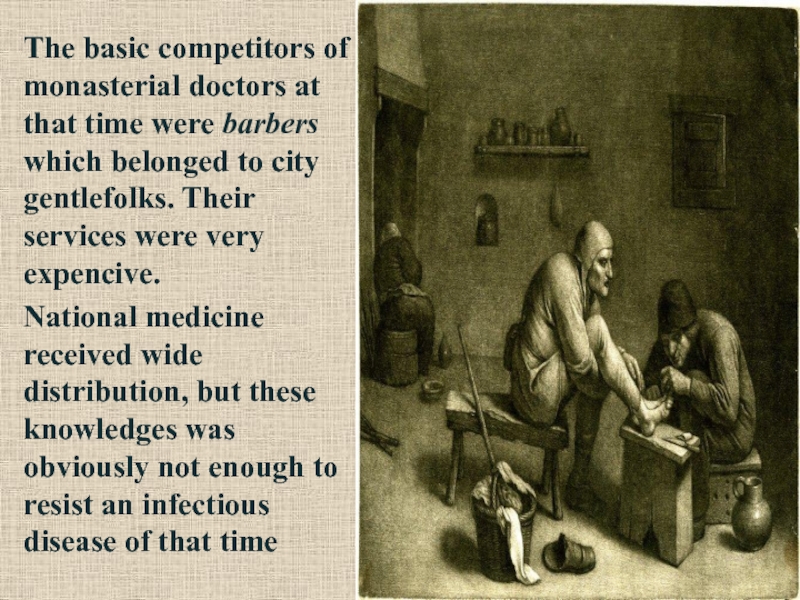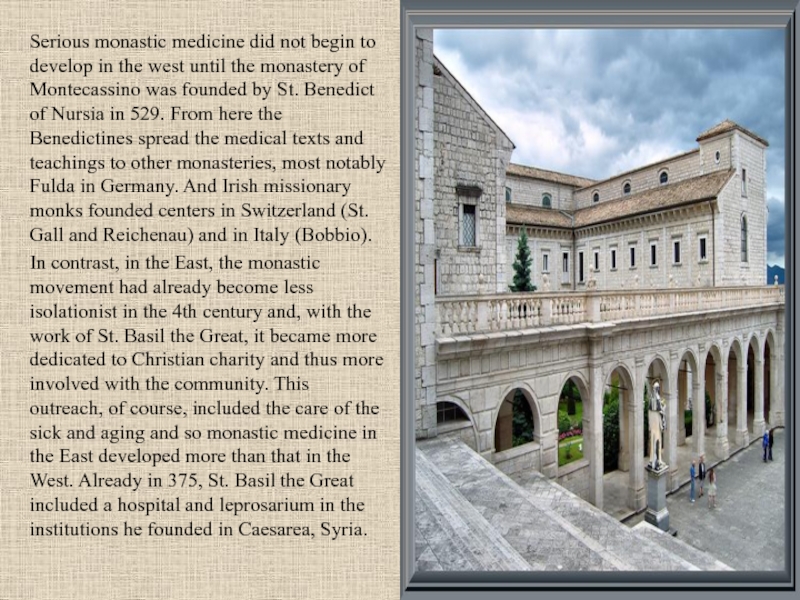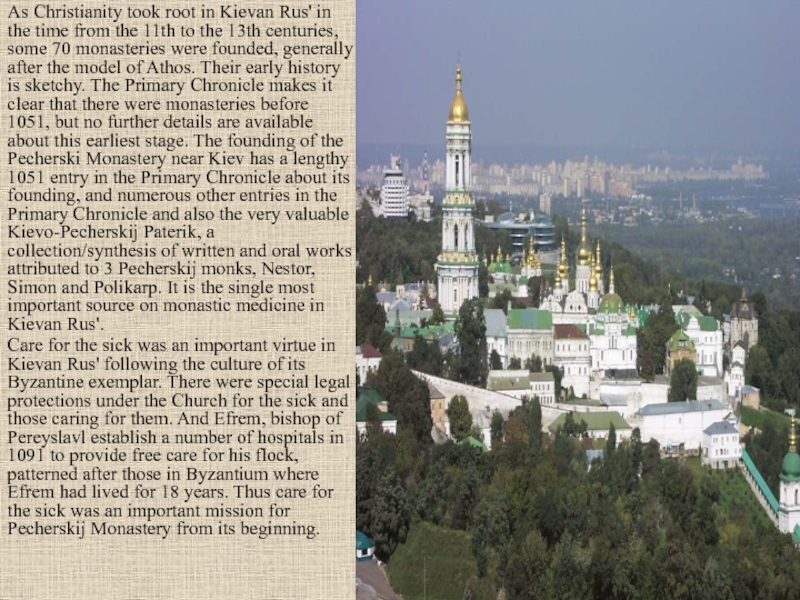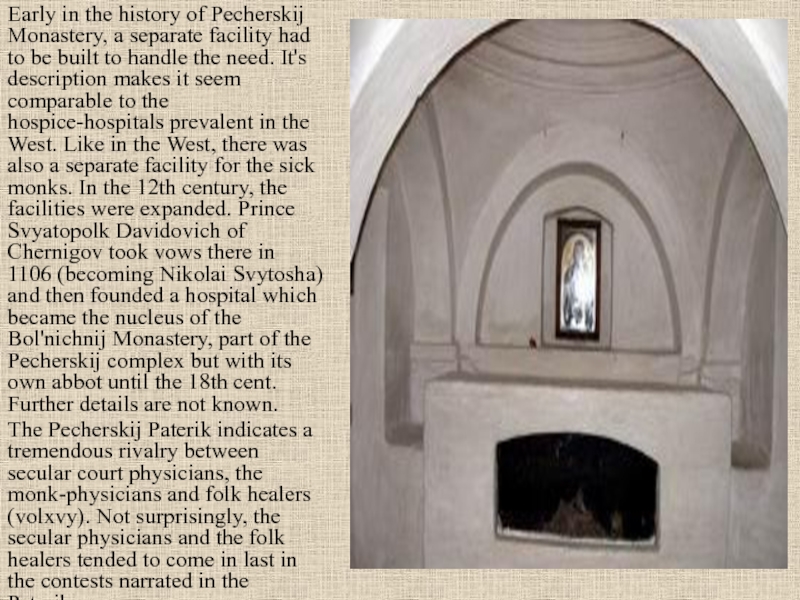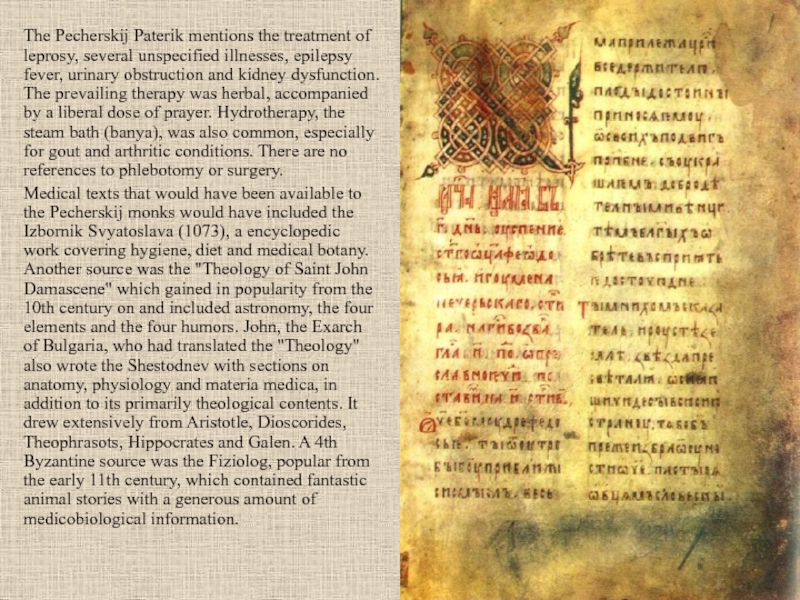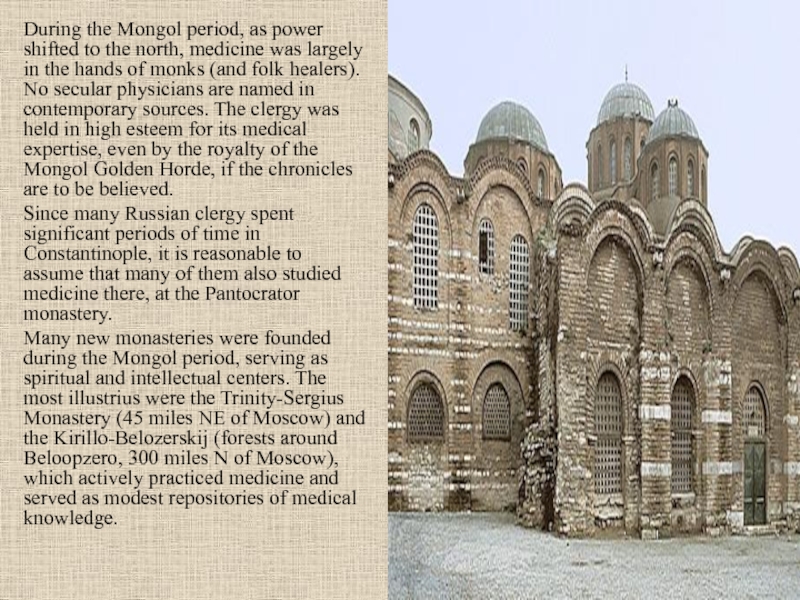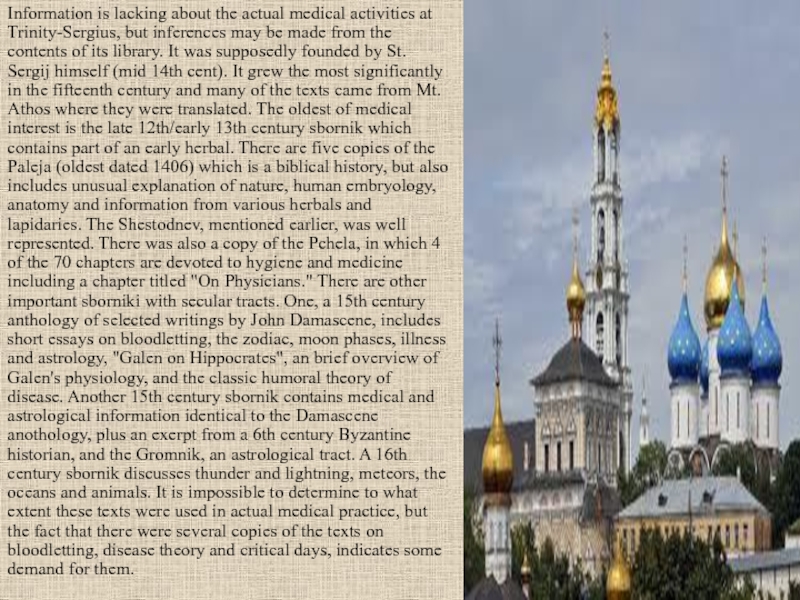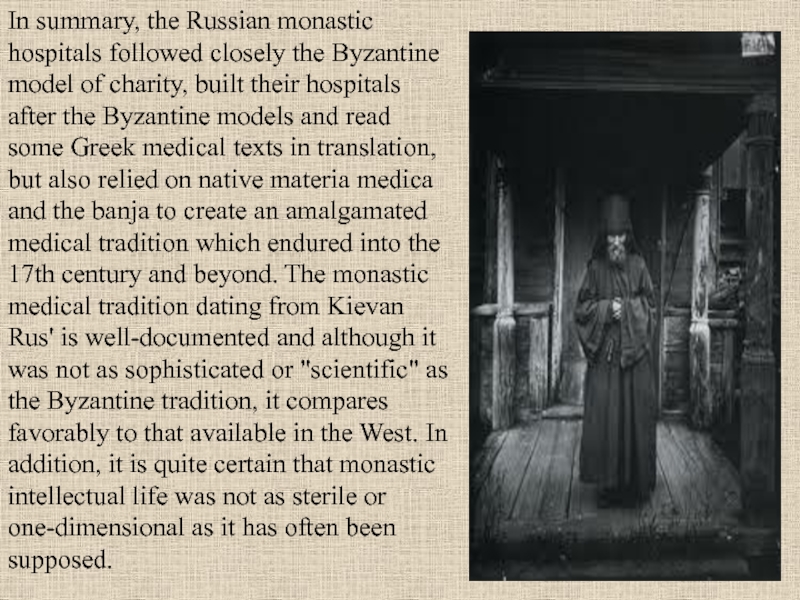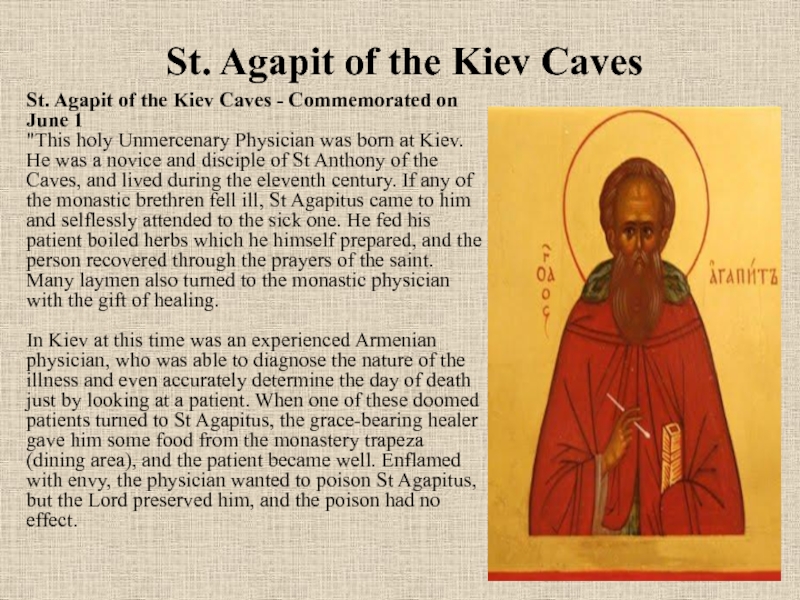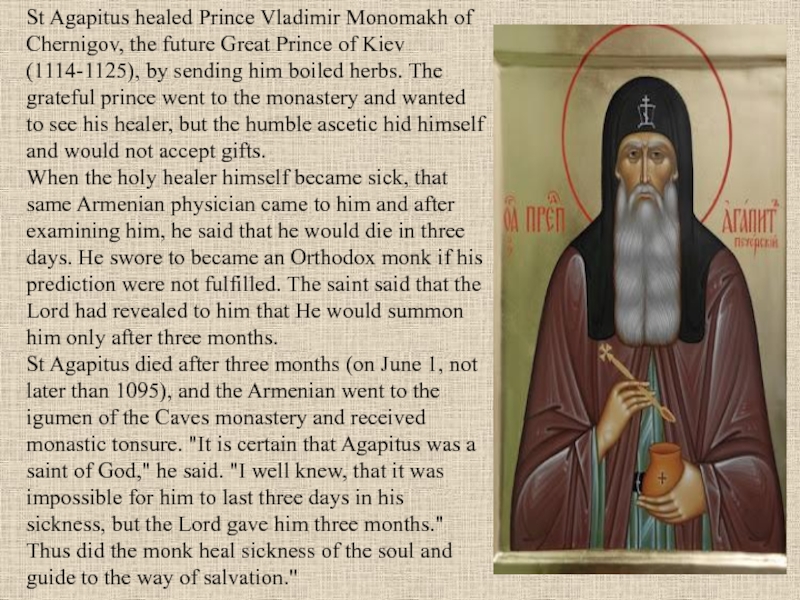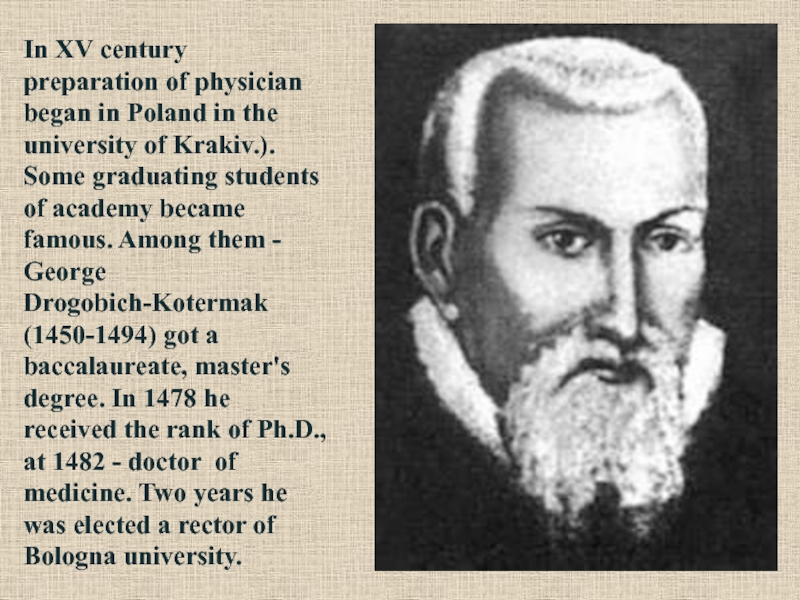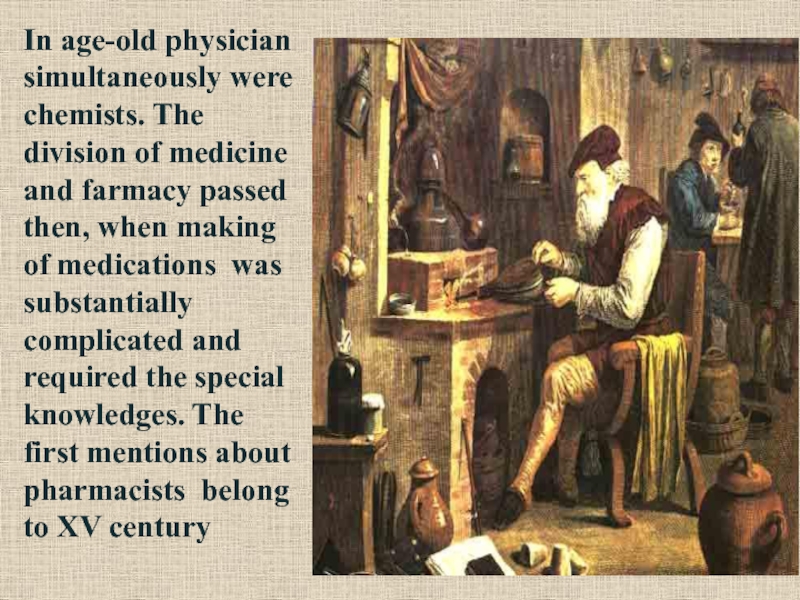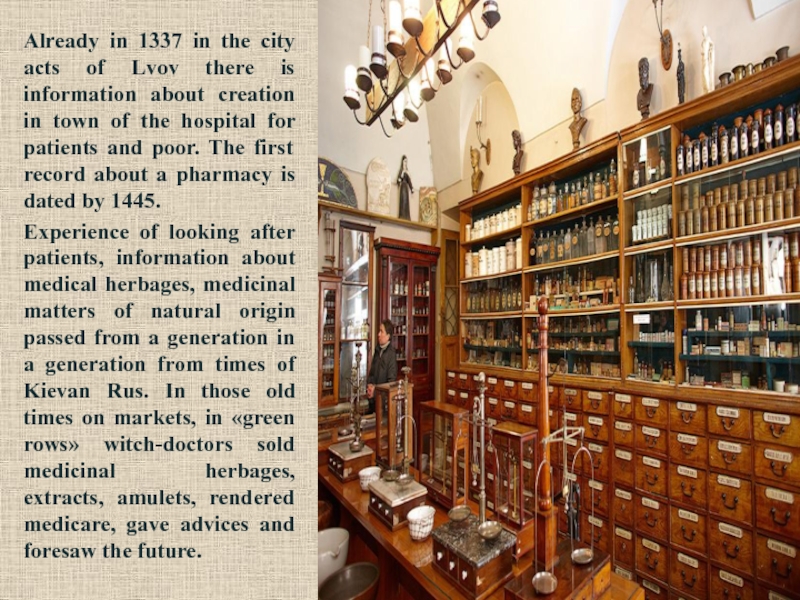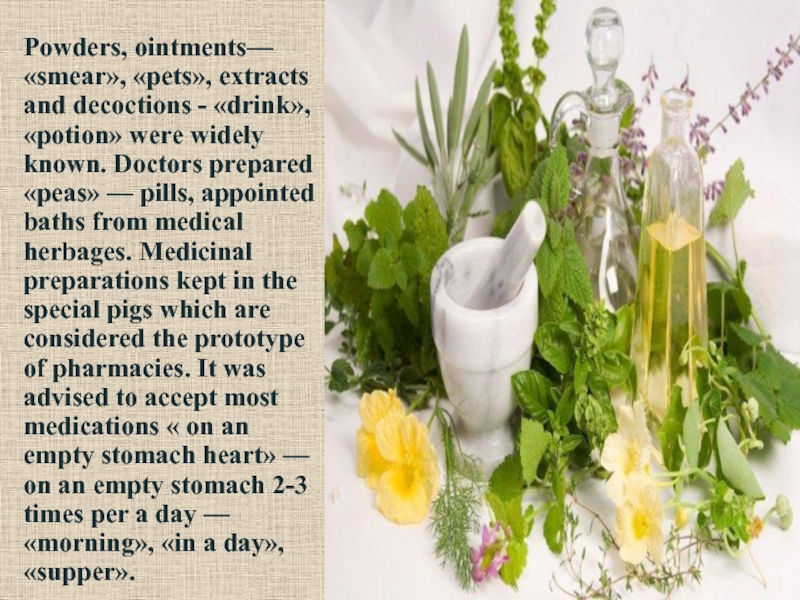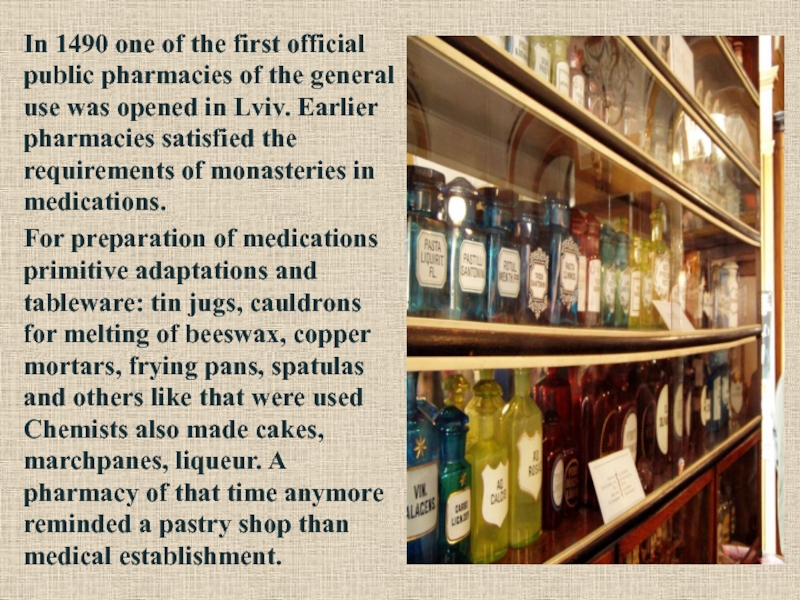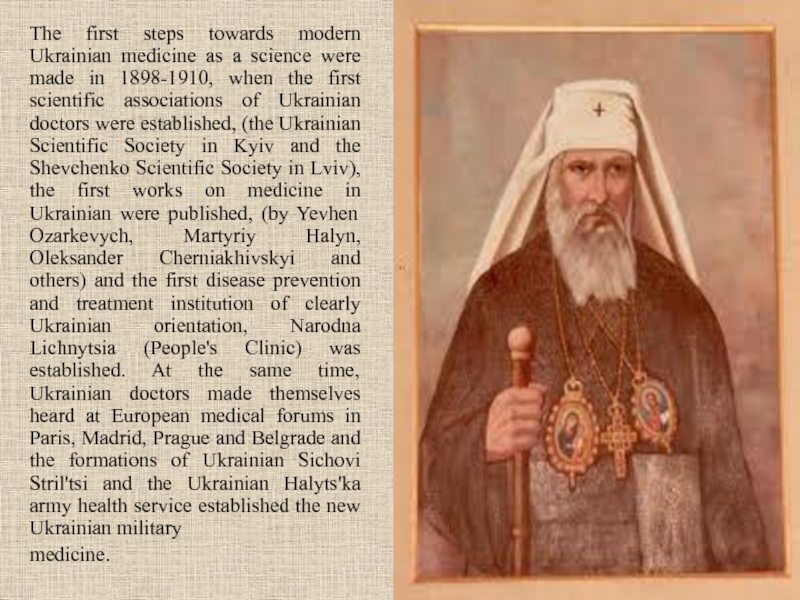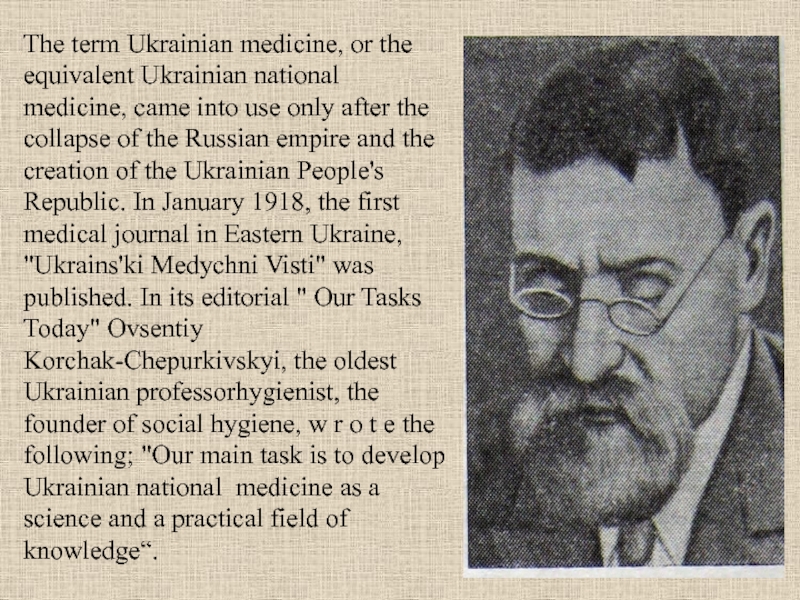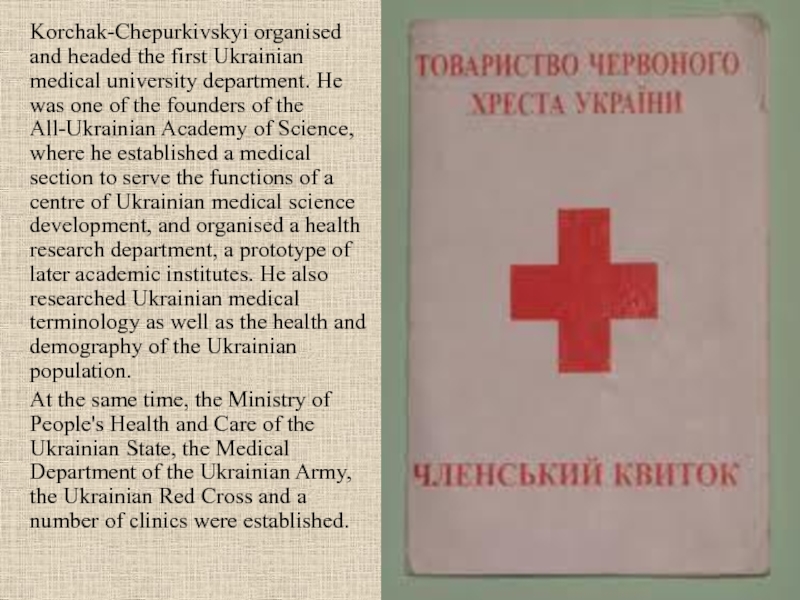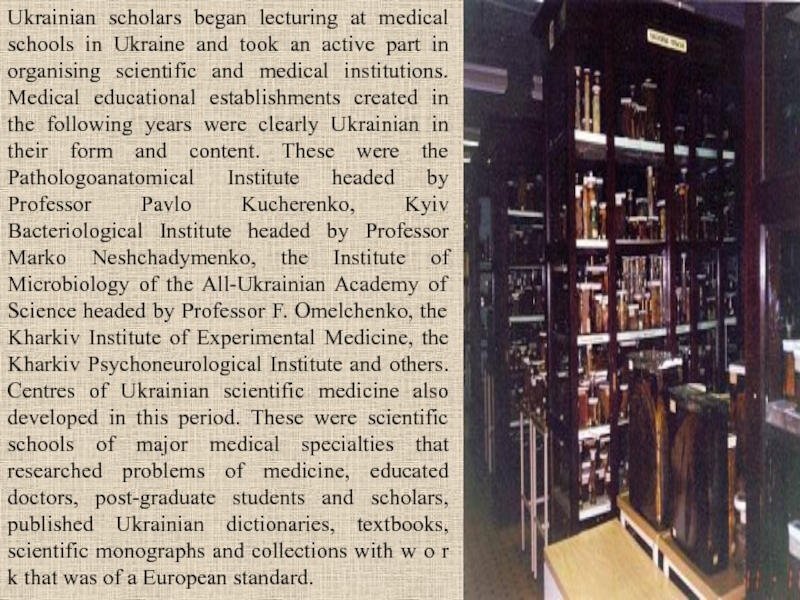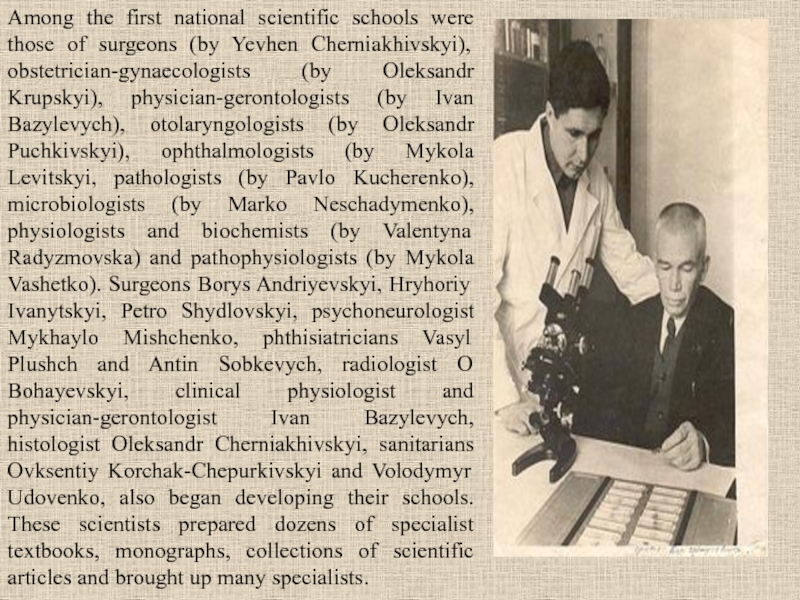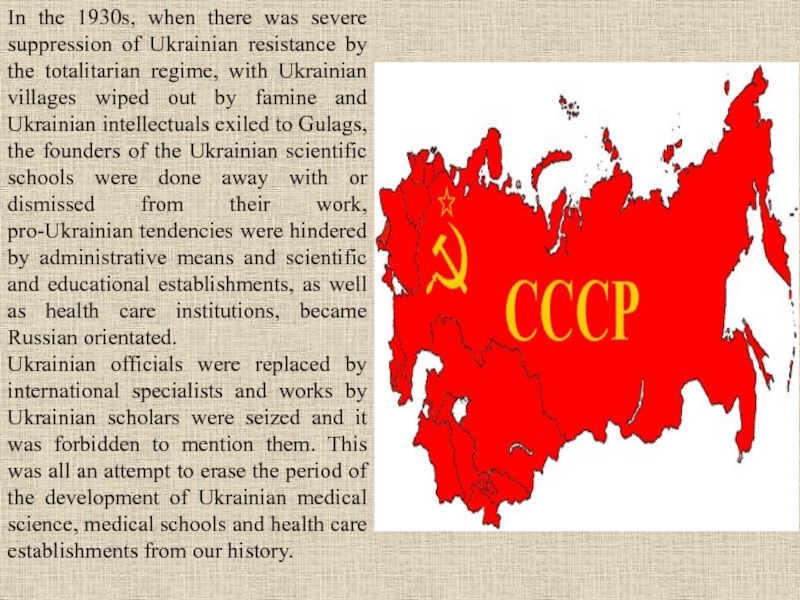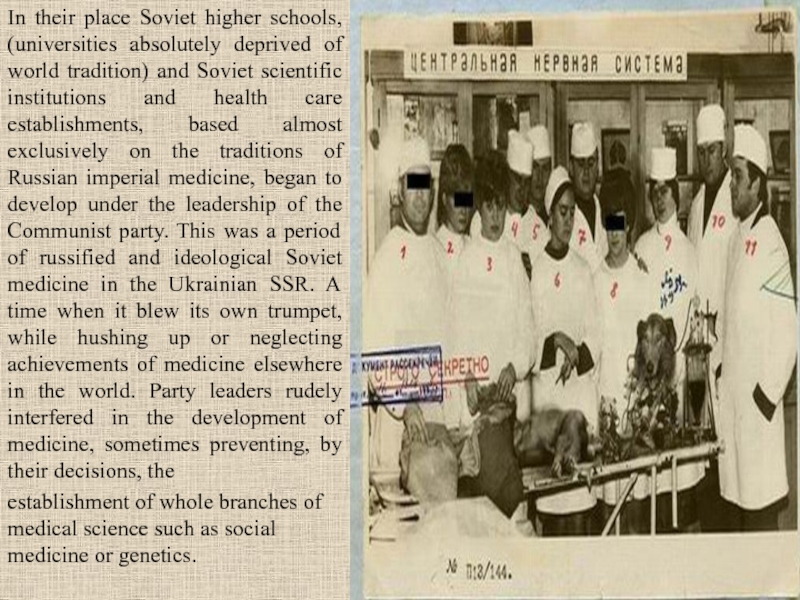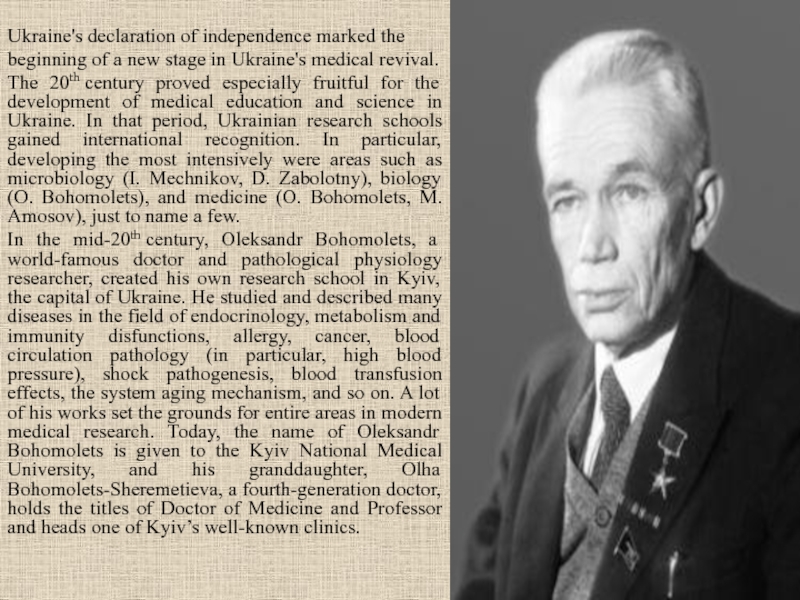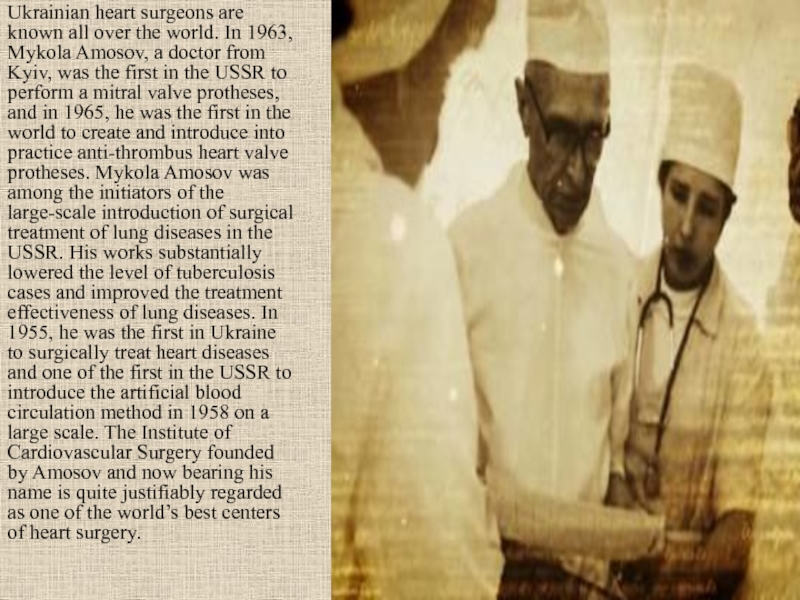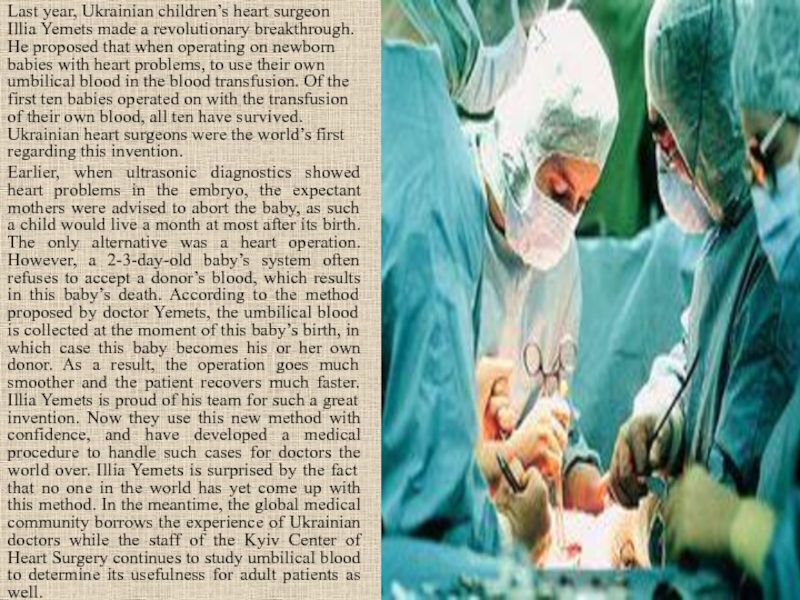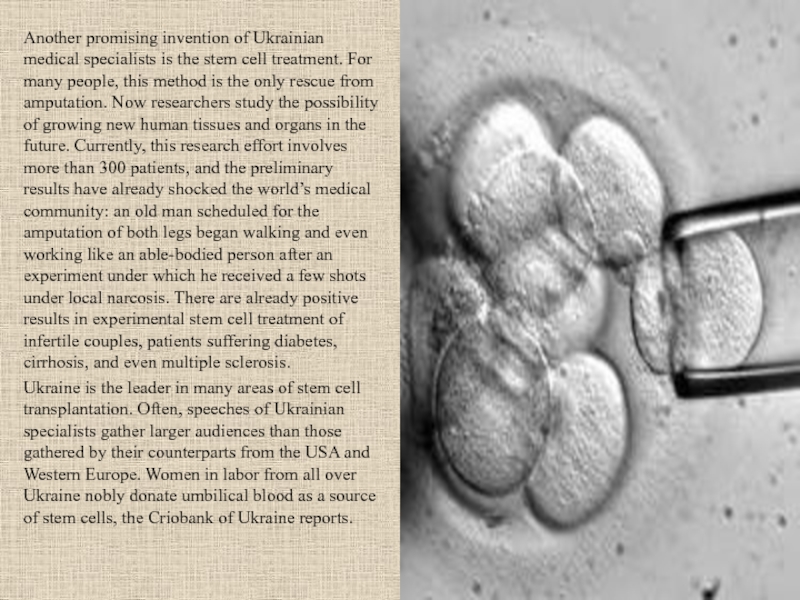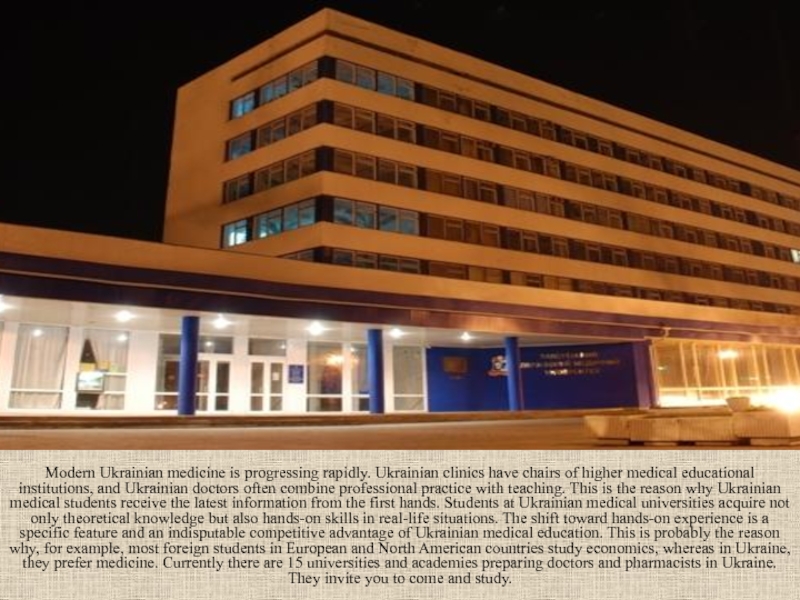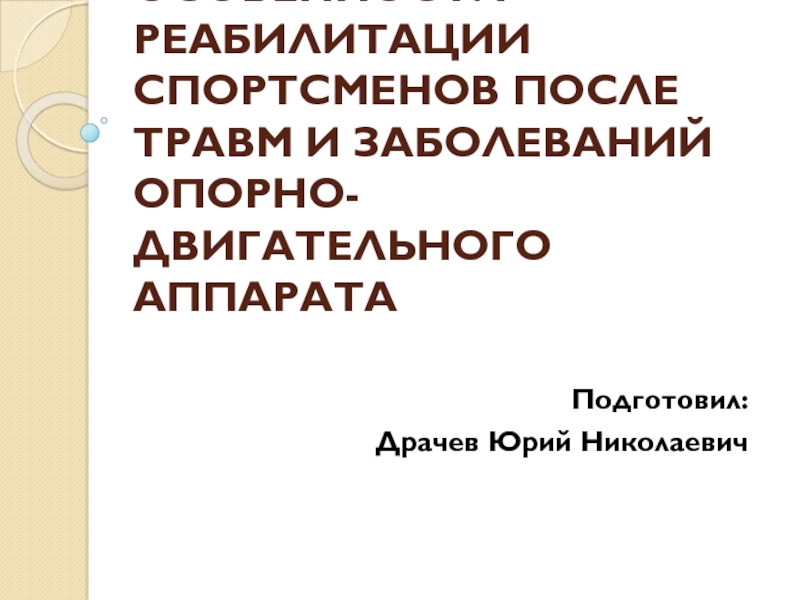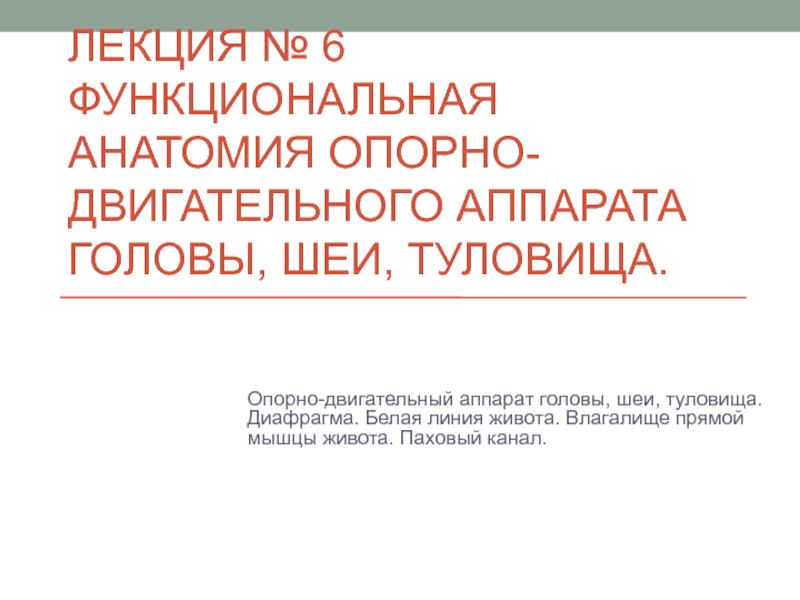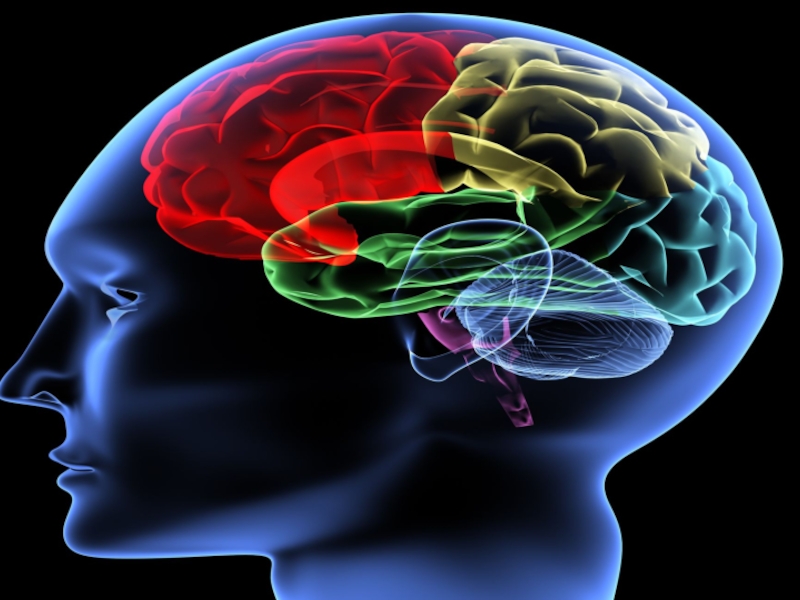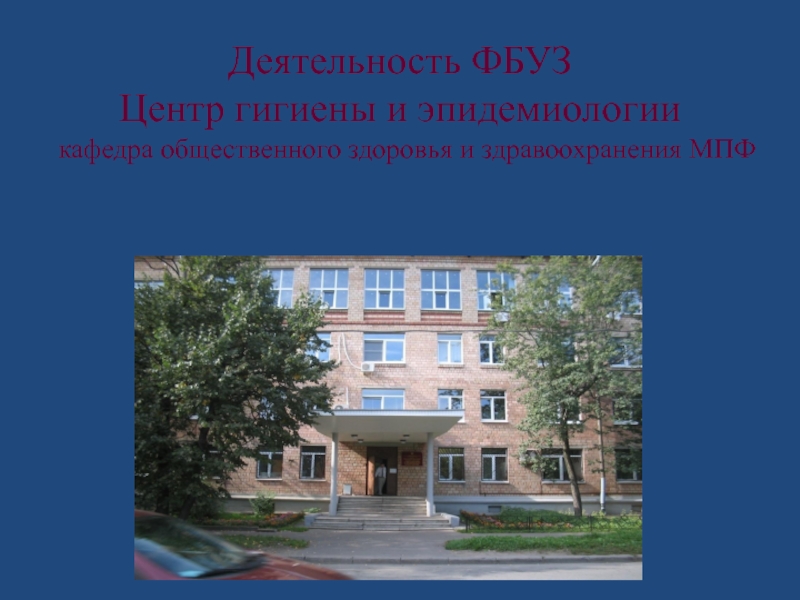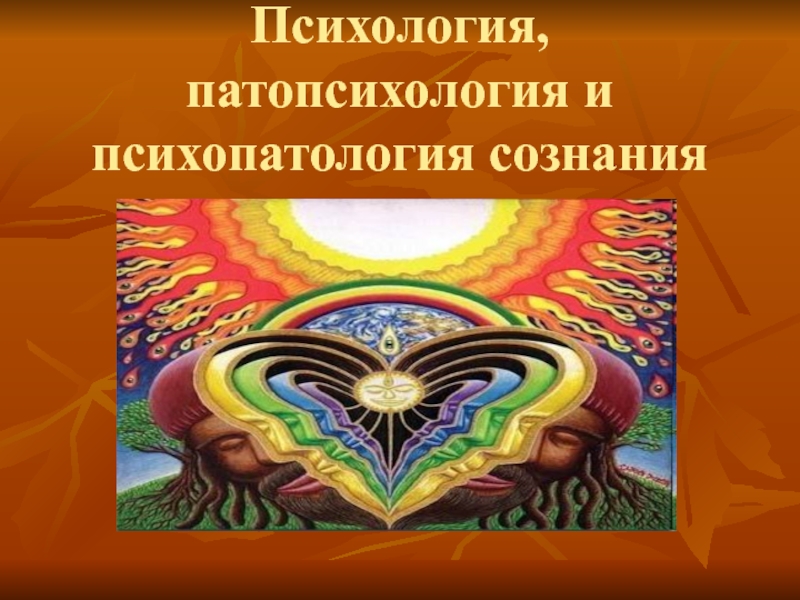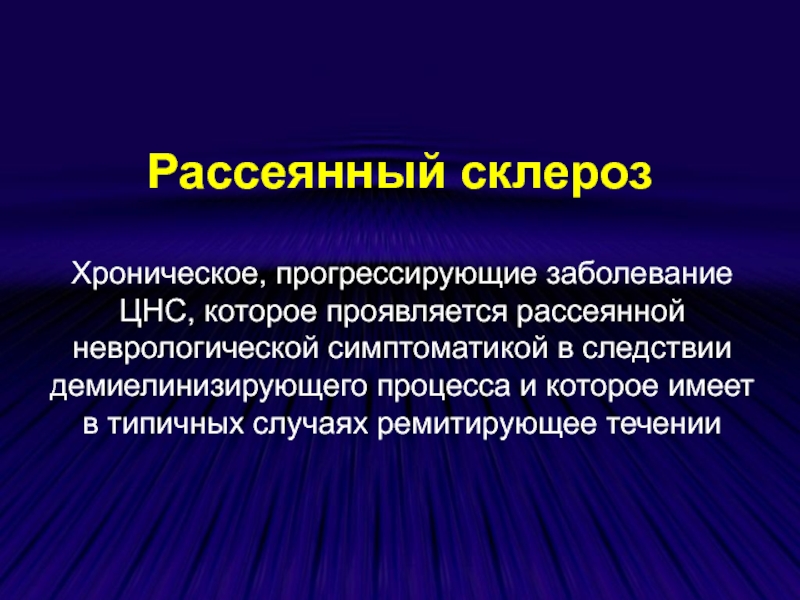- Главная
- Разное
- Дизайн
- Бизнес и предпринимательство
- Аналитика
- Образование
- Развлечения
- Красота и здоровье
- Финансы
- Государство
- Путешествия
- Спорт
- Недвижимость
- Армия
- Графика
- Культурология
- Еда и кулинария
- Лингвистика
- Английский язык
- Астрономия
- Алгебра
- Биология
- География
- Детские презентации
- Информатика
- История
- Литература
- Маркетинг
- Математика
- Медицина
- Менеджмент
- Музыка
- МХК
- Немецкий язык
- ОБЖ
- Обществознание
- Окружающий мир
- Педагогика
- Русский язык
- Технология
- Физика
- Философия
- Химия
- Шаблоны, картинки для презентаций
- Экология
- Экономика
- Юриспруденция
Medicine of the 20th century презентация
Содержание
- 1. Medicine of the 20th century
- 2. INFECTIOUS DISEASES AND CHEMOTHERAPY
- 3. EHRLICH AND ARSPHENAMINE Paul Ehrlich In 1910,
- 4. SULFONAMIDE DRUGS In 1932 the German
- 6. ANTITUBERCULOSIS DRUGS
- 8. INSULIN In 1921, Frederick Banting
- 9. In 1923 Frederick G. Banting and
- 10. CORTISONE In 1949 Philip S. Hench and
- 11. VITAMINS Hopkins demonstrated the need for thiamine
- 12. Тhe human blood groups The
- 13. ECG The Nobel Prize in Physiology or
- 14. TROPICAL MEDICINE
- 15. Medical ultrasonography Ultrasonic energy was first applied
- 16. Computerized axial tomography The first commercially
- 17. Surgery In The 20th Century
- 18. The problem of Shock The first problem
- 19. Hermann Kümmell, of Hamburg, devised the routine
- 21. ABDOMINAL SURGERY In 1881 Billroth had performed the
- 22. HEART SURGERY 1912 – OPERATION
- 23. ORGAN TRANSPLANTATION 1905: First successful cornea transplant
- 24. THE MISTAKES OF MEDICINE
- 25. THE SOOTHING SYRUP FOR THE CHILDREN In
- 27. THE MERCURY A physician Robert Patric promised
- 28. THE LOBOTOMY The dissection of the brain
- 29. THE URINOTHERAPY It is
- 30. THE PHLEBOTOMY THE METHOD OF PHLEBOOTOMY (
- 31. THE PILLS FOR WEIGHT LOSS IN 20TH
- 32. THE CEPHALOTRYPESIS This inhuman method was very
- 33. THE TRAGEDY OF THALIDOMIDE Thalidomide was a
- 35. HISTORY OF UKRAINIAN MEDICINE.
- 36. Medicine of Scythia Opening of tripolska civilization
- 37. Scythians in VII c B.C. populated Crimea
- 38. «Father of botany» Feofrast in his texts
- 39. Facilities of animal origin had wide application
- 40. Known greek writer Plutarkh (46-120 ð.ð. A.D.)
- 41. A treatise of Evpraksiya about „Ointments” History
- 42. This treatise consists of 5 parts. In
- 43. It is known from history, that in
- 44. The basic competitors of monasterial doctors at
- 45. Serious monastic medicine did not begin to
- 46. As Christianity took root in Kievan Rus'
- 47. Early in the history of Pecherskij Monastery,
- 48. The Pecherskij Paterik mentions the treatment of
- 49. During the Mongol period, as power shifted
- 50. Information is lacking about the actual medical
- 51. In summary, the Russian monastic hospitals followed
- 52. St. Agapit of the Kiev Caves
- 53. St Agapitus healed Prince Vladimir Monomakh of
- 54. In XV century preparation of physician began
- 55. In age-old physician simultaneously were chemists. The
- 56. Already in 1337 in the city acts
- 57. Powders, ointments— «smear», «pets», extracts and decoctions
- 58. In 1490 one of the first official
- 59. The first steps towards modern Ukrainian medicine
- 60. The term Ukrainian medicine, or the equivalent
- 61. Korchak-Chepurkivskyi organised and headed the first Ukrainian
- 62. Ukrainian scholars began lecturing at medical schools
- 63. Among the first national scientific schools were
- 64. In the 1930s, when there was severe
- 65. In their place Soviet higher schools, (universities
- 66. Ukraine's declaration of independence marked the
- 67. Ukrainian heart surgeons are known all over
- 68. Last year, Ukrainian children’s heart surgeon Illia
- 69. Another promising invention of Ukrainian medical specialists
- 70. Modern Ukrainian medicine is progressing rapidly. Ukrainian
Слайд 3EHRLICH AND ARSPHENAMINE Paul Ehrlich In 1910, with his colleague Sahachiro Hata,
Слайд 4SULFONAMIDE DRUGS
In 1932 the German bacteriologist Gerhard Domagk announced that the red
Слайд 5
In 1928 ALEXANDER FLEMING noticed the inhibitory activity of a stray mold on a plate culture of staphylococcus bacteria.
In 1938 HOWARD FLORY, ERNEST CHAIN received pure penicillin.
In 1945 ALEXANDER FLEMING, HOWARD FLORY, ERNEST CHAIN won the Noble Prize for the discovery of penicillin and its curative effect in various infectious diseases.
Слайд 6 ANTITUBERCULOSIS DRUGS
In 1944, SELMAN WAXMAN announced
Clinincal trials confirmed this claim.
The Nobel Prize in Medicine 1952 was awarded to Selman A. Waksman
Слайд 7 IMMUNOLOGY
In
Jules Bordet had identified antibodies in the blood serum.
The mechanisms of antibody activity were used to devise diagnostic tests for a number of diseases.
In 1906 August von Wassermann gave his name to the blood test for syphilis, and in 1908 the tuberculin test—the skin test for tuberculosis—came into use.
Слайд 8
INSULIN
In 1921, Frederick Banting and Charles H. Best isolated insulin. They then
The following year a 14-year-old boy with severe diabetes was the first person to be treated successfully with the pancreatic extracts.
Слайд 9 In 1923 Frederick G. Banting and John Macleod were awarded
Слайд 10CORTISONE
In 1949 Philip S. Hench and his colleagues announced that a substance
This was compound E, or cortisone, as it came to be known, which had been isolated by Edward C. Kendall in 1935.
Слайд 11VITAMINS
Hopkins demonstrated the need for thiamine in the diet in publications
The name vitamin was suggested by Casimir Funk , in the belief that they were amines( then term was altered to vitamin). Now, by supplementing the diet with vitamins, deficiency diseases such as rickets, scurvey and beriberi practically disappeared.
Слайд 12 Тhe human blood groups
The discovery of human blood groups
Слайд 13ECG The Nobel Prize in Physiology or Medicine 1924 was awarded to
Слайд 14 TROPICAL MEDICINE The first half of the 20th century witnessed
The Nobel Prize in Physiology or Medicine 1948 was awarded to Paul Müller "for his discovery of the high efficiency of DDT as a contact poison against several arthropods".
The major problem was that the mosquitoes were able to develop a resistance to DDT. Now DDT is strongly criticized by ecologists.
Слайд 15Medical ultrasonography
Ultrasonic energy was first applied to the human body for
English born and educated John Wild (1914–2009) first used ultrasound to assess the thickness of bowel tissue as early as 1949: for his early work he has been described as the "father of medical ultrasound".[
Слайд 16Computerized axial tomography
The first commercially viable CT scanner was invented
Hounsfield conceived his idea in 1967 and the first patient brain-scan was done on 1 October 1971. It was publicly announced in 1972.
Hounsfield and Cormack shared the 1979 Nobel Prize in Medicine.
Слайд 18The problem of Shock The first problem of the surgery in the
In 1901 Karl Landsteiner discovered the AB0 blood groups . In 1914 sodium citrate was added to freshly drawn blood to prevent clotting.
As blood transfusion increased in frequency and volume blood banks were required.
In 1933 S.S. Yudin used cadaver blood.
In 1937 B. Fantus used living donors.
Слайд 19Hermann Kümmell, of Hamburg, devised the routine of “scrubbing up.”
In
In 1896 Johannes von Mikulicz-Radecki, a Pole working at Breslau, Ger., invented the gauze mask.
Aseptic and antiseptic
Слайд 20
IN 1933 – INTRODUCTION OF THE GENERAL ANESTHTIC CYCLOPROPANE BY RALPH WATERS
IN 1937 – INTRAVENOSUS ANESTHESIA WAS INTRODUCED – JOHN LUNDY USED PENTOTHAL FOR FIRST
IN 1942 GRIFFITH AND JOHNSON PRODUCED MUSCULAR PARALYSIS BY THE INJECTION OF CURARE
Слайд 21ABDOMINAL SURGERY
In 1881 Billroth had performed the first successful removal of part
By 1891 had carried out 41 more of these operations with 16 deaths—a remarkable achievement for that era.
Слайд 22HEART SURGERY
1912 – OPERATION ON THE AORTIC VALVE (
1923 – CUTLER OPERATED MITRAL STENOSIS
1938 - GROSS SUCCESSFULLY TIED OFF A PERSISTENT DUCTUS ARTERIOSUS
1953 – JOHN GIBBON USED THE HEART- LUNG MACHINE TO SUPPLY OXYGEN WHILE HE CLOSED A HOLE IN THE SEPTUM BETWEEN THE ATRIA
A NEW FORM OF HEART SURGERY IS VERY POPULAR NOW – ROBOT-ASSISTED SURGERY.
Слайд 23ORGAN TRANSPLANTATION
1905: First successful cornea transplant by Eduard Zirm
1954: First successful
1967: First successful liver transplant
1967: First successful heart transplant by Christian Barnard
1986: First successful double-lung transplant
1998: First successful hand transplant
2010: First full facial transplant
2011: First double leg transplant
Слайд 25THE SOOTHING SYRUP FOR THE CHILDREN
In 19th century this soothing syrup
Слайд 26
IT
Слайд 27THE MERCURY
A physician Robert Patric promised to cure almost all diseases
Слайд 28THE LOBOTOMY
The dissection of the brain was very popular in the
Слайд 29 THE URINOTHERAPY
It is difficult to imagine, but throughout
Слайд 30THE PHLEBOTOMY
THE METHOD OF PHLEBOOTOMY ( BLOODLETTING) WAS VERY POPULAR DURING
Слайд 31THE PILLS FOR WEIGHT LOSS
IN 20TH CENTURY OBSSESION OF MANY WOMEN
Слайд 32THE CEPHALOTRYPESIS
This inhuman method was very popular way of treating of
Слайд 33THE TRAGEDY OF THALIDOMIDE
Thalidomide was a drug, which after years of
Слайд 36Medicine of Scythia
Opening of tripolska civilization which attained the bloom for
Слайд 37Scythians in VII c B.C. populated Crimea and territory between Dniper
Scythians, as well as any peoples, had certain knowledge in the relation of treatment of different deseases and damages. Gold vases were found with the representation of scythians which render a medical help (bandaging of extremities, extrfction of teeth) during excavations of Chertomlinskij burial mound (near Nikopol)
Слайд 38«Father of botany» Feofrast in his texts (370-285 B.C.) mentions «Sweet
Слайд 39Facilities of animal origin had wide application in scythian medicine (beaver
It is here necessary to underline the special importance of steam „scythian bath-house” in relation tosanitary – hygienical measuresof scythian population
Слайд 40Known greek writer Plutarkh (46-120 ð.ð. A.D.) mentions, that on stream
Scythians used juice of this plant for rubbing of surface of body which guarded them from a chill and cold. For scythians hemp juice, extract of root of mandrake, opium served as anesthetics at surgical intervention. Scythian women, on the certificate of Gerodota, were able to make cosmetic ointments for a skin. They «grind by rough stone cypress, cedar and lavender tree and topping up water to them».
Слайд 41A treatise of Evpraksiya about „Ointments”
History of Evpraksija is such. From
Then she began to treat poor people.
Consisting of medicine of Kievan Rus is well shown in the work of Evpraksija Kievan (Zoy) - the grandchild of Vladimir Monomakh, which is written by her in Byzantium
Слайд 42This treatise consists of 5 parts. In the first part is
Слайд 43It is known from history, that in XI century there were
So there was monasterial medicine.
Слайд 44The basic competitors of monasterial doctors at that time were barbers
National medicine received wide distribution, but these knowledges was obviously not enough to resist an infectious disease of that time
Слайд 45Serious monastic medicine did not begin to develop in the west
In contrast, in the East, the monastic movement had already become less isolationist in the 4th century and, with the work of St. Basil the Great, it became more dedicated to Christian charity and thus more involved with the community. This outreach, of course, included the care of the sick and aging and so monastic medicine in the East developed more than that in the West. Already in 375, St. Basil the Great included a hospital and leprosarium in the institutions he founded in Caesarea, Syria.
Слайд 46As Christianity took root in Kievan Rus' in the time from
Care for the sick was an important virtue in Kievan Rus' following the culture of its Byzantine exemplar. There were special legal protections under the Church for the sick and those caring for them. And Efrem, bishop of Pereyslavl establish a number of hospitals in 1091 to provide free care for his flock, patterned after those in Byzantium where Efrem had lived for 18 years. Thus care for the sick was an important mission for Pecherskij Monastery from its beginning.
Слайд 47Early in the history of Pecherskij Monastery, a separate facility had
The Pecherskij Paterik indicates a tremendous rivalry between secular court physicians, the monk-physicians and folk healers (volxvy). Not surprisingly, the secular physicians and the folk healers tended to come in last in the contests narrated in the Paterik.
Слайд 48The Pecherskij Paterik mentions the treatment of leprosy, several unspecified illnesses,
Medical texts that would have been available to the Pecherskij monks would have included the Izbornik Svyatoslava (1073), a encyclopedic work covering hygiene, diet and medical botany. Another source was the "Theology of Saint John Damascene" which gained in popularity from the 10th century on and included astronomy, the four elements and the four humors. John, the Exarch of Bulgaria, who had translated the "Theology" also wrote the Shestodnev with sections on anatomy, physiology and materia medica, in addition to its primarily theological contents. It drew extensively from Aristotle, Dioscorides, Theophrasots, Hippocrates and Galen. A 4th Byzantine source was the Fiziolog, popular from the early 11th century, which contained fantastic animal stories with a generous amount of medicobiological information.
Слайд 49During the Mongol period, as power shifted to the north, medicine
Since many Russian clergy spent significant periods of time in Constantinople, it is reasonable to assume that many of them also studied medicine there, at the Pantocrator monastery.
Many new monasteries were founded during the Mongol period, serving as spiritual and intellectual centers. The most illustrius were the Trinity-Sergius Monastery (45 miles NE of Moscow) and the Kirillo-Belozerskij (forests around Beloopzero, 300 miles N of Moscow), which actively practiced medicine and served as modest repositories of medical knowledge.
Слайд 50Information is lacking about the actual medical activities at Trinity-Sergius, but
Слайд 51In summary, the Russian monastic hospitals followed closely the Byzantine model
Слайд 52St. Agapit of the Kiev Caves
St. Agapit of the Kiev
Слайд 53St Agapitus healed Prince Vladimir Monomakh of Chernigov, the future Great
Слайд 54In XV century preparation of physician began in Poland in the
Слайд 55In age-old physician simultaneously were chemists. The division of medicine and
Слайд 56Already in 1337 in the city acts of Lvov there is
Experience of looking after patients, information about medical herbages, medicinal matters of natural origin passed from a generation in a generation from times of Kievan Rus. In those old times on markets, in «green rows» witch-doctors sold medicinal herbages, extracts, amulets, rendered medicare, gave advices and foresaw the future.
Слайд 57Powders, ointments— «smear», «pets», extracts and decoctions - «drink», «potion» were
Слайд 58In 1490 one of the first official public pharmacies of the
For preparation of medications primitive adaptations and tableware: tin jugs, cauldrons for melting of beeswax, copper mortars, frying pans, spatulas and others like that were used Chemists also made cakes, marchpanes, liqueur. A pharmacy of that time anymore reminded a pastry shop than medical establishment.
Слайд 59The first steps towards modern Ukrainian medicine as a science were
medicine.
Слайд 60The term Ukrainian medicine, or the equivalent Ukrainian national medicine, came
Слайд 61Korchak-Chepurkivskyi organised and headed the first Ukrainian medical university department. He
At the same time, the Ministry of People's Health and Care of the Ukrainian State, the Medical Department of the Ukrainian Army, the Ukrainian Red Cross and a number of clinics were established.
Слайд 62Ukrainian scholars began lecturing at medical schools in Ukraine and took
Слайд 63Among the first national scientific schools were those of surgeons (by
Слайд 64In the 1930s, when there was severe suppression of Ukrainian resistance
Ukrainian officials were replaced by international specialists and works by Ukrainian scholars were seized and it was forbidden to mention them. This was all an attempt to erase the period of the development of Ukrainian medical science, medical schools and health care establishments from our history.
Слайд 65In their place Soviet higher schools, (universities absolutely deprived of world
establishment of whole branches of medical science such as social medicine or genetics.
Слайд 66
Ukraine's declaration of independence marked the
beginning of a new stage in
The 20th century proved especially fruitful for the development of medical education and science in Ukraine. In that period, Ukrainian research schools gained international recognition. In particular, developing the most intensively were areas such as microbiology (I. Mechnikov, D. Zabolotny), biology (O. Bohomolets), and medicine (O. Bohomolets, M. Amosov), just to name a few.
In the mid-20th century, Oleksandr Bohomolets, a world-famous doctor and pathological physiology researcher, created his own research school in Kyiv, the capital of Ukraine. He studied and described many diseases in the field of endocrinology, metabolism and immunity disfunctions, allergy, cancer, blood circulation pathology (in particular, high blood pressure), shock pathogenesis, blood transfusion effects, the system aging mechanism, and so on. A lot of his works set the grounds for entire areas in modern medical research. Today, the name of Oleksandr Bohomolets is given to the Kyiv National Medical University, and his granddaughter, Olha Bohomolets-Sheremetieva, a fourth-generation doctor, holds the titles of Doctor of Medicine and Professor and heads one of Kyiv’s well-known clinics.
Слайд 67Ukrainian heart surgeons are known all over the world. In 1963,
Слайд 68Last year, Ukrainian children’s heart surgeon Illia Yemets made a revolutionary
Earlier, when ultrasonic diagnostics showed heart problems in the embryo, the expectant mothers were advised to abort the baby, as such a child would live a month at most after its birth. The only alternative was a heart operation. However, a 2-3-day-old baby’s system often refuses to accept a donor’s blood, which results in this baby’s death. According to the method proposed by doctor Yemets, the umbilical blood is collected at the moment of this baby’s birth, in which case this baby becomes his or her own donor. As a result, the operation goes much smoother and the patient recovers much faster. Illia Yemets is proud of his team for such a great invention. Now they use this new method with confidence, and have developed a medical procedure to handle such cases for doctors the world over. Illia Yemets is surprised by the fact that no one in the world has yet come up with this method. In the meantime, the global medical community borrows the experience of Ukrainian doctors while the staff of the Kyiv Center of Heart Surgery continues to study umbilical blood to determine its usefulness for adult patients as well.
Слайд 69Another promising invention of Ukrainian medical specialists is the stem cell
Ukraine is the leader in many areas of stem cell transplantation. Often, speeches of Ukrainian specialists gather larger audiences than those gathered by their counterparts from the USA and Western Europe. Women in labor from all over Ukraine nobly donate umbilical blood as a source of stem cells, the Criobank of Ukraine reports.
